lordroel
Administrator
Posts: 68,081 
Likes: 49,471
|
Post by lordroel on Aug 19, 2022 5:41:03 GMT
Day 1436 of World War II, August 19th 1943Eastern FrontAfter three days of heavy fighting, the Soviet Southwest Front broke through the German defenses on the Mius River line. Air War over Europe8 Mosquitoes went to Berlin, 1 aircraft lost. German bombs were scattered widely over the country, some falling in Yorkshire. The US Eighth Air Force's VIII Air Support Command and VIII Bomber Command in England both fly missions. The US VIII Air Support Command flew Missions 27A, 27B and 28 against 3 Luftwaffe airfields in France without loss. 36 B-26B Marauders bombed Glisy Airfield at Amiens, 35 B-26s attacked Nord Airfield at Poix and 36 B-26s were dispatched to Bryas Sud Airfield but the target was obscured by cloud and the mission was aborted. Fighters from 4./JG 26 intercepted the escorting Typhoons and shot down 3 of the planes without loss. The US VIII Bomber Command flew Mission 85 against 3 Luftwaffe airfields in The Netherlands. 38 B-17s attacked Gilze-Rijen and 55 hit Flushing, losing 4 B-17s. Escort was provided by 175 P-47 Thunderbolts of the 4th, 78th, 56th and 353d FGs who claimed 9-2-4 Luftwaffe aircraft but 1 P-47 was lost. 45 B-17s were dispatched to Woensdrecht Airfield but weather prevented them hitting the target. Luftwaffe fighters from JG 26 went sent to intercept but the escorts gave them a rough time. 3 Fw 190s were shot down before reaching the bombers. U.S. General Bedell Smith, Eisenhower's Chief of Staff, and British General Kenneth Strong arrived in Lisbon to continue discussions with the Italians about surrender negotiations. General Giuseppe Castellano heads the Italian delegation. Castellano wanted an agreement that would allow Italy to join the Allies and fight the Germans. He's shocked when the Allies insist on unconditional surrender. Battle of the AtlanticAircraft of Composite Squadron Twenty Five (VC 25) from the escort aircraft carrier USS 'Croatan' (CVE-25) attacked the German submarine 'U-134', northwest of the Azores, but the sub escaped. Battle of the MediterraneanThe US Ninth Air Force in North Africa sent about 70 B-24s to bomb the marshalling yard at Foggia, Italy. The Northwest African Strategic Air Force dispatched 150+ B-17s to bomb the Foggia marshalling yard, while almost 100 medium bombers hit marshalling yards at Sapri and Salerno. The bombers, and escorting P-38 Lightnings claimed 34 enemy planes shot down, against 8 losses. United States Photo: The U.S. Navy destroyer USS Bainbridge (DD-246) in New York Harbor (USA), on 19 August 1943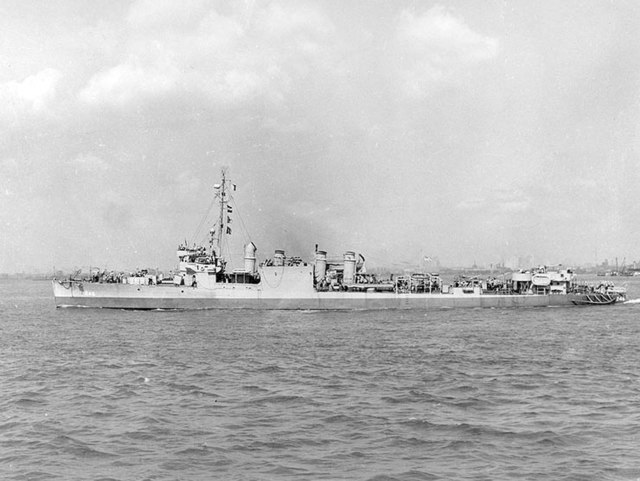 Pacific War Pacific WarBURMA-INDIA (Tenth Air Force): Brigadier General Howard C Davidson becomes Commanding General Tenth Air Force. SOUTH PACIFIC THEATER OF OPERATIONS (Thirteenth Air Force): In the Solomon Islands, B-25's, operating in pairs and with fighter escort, hit barges at Timbala Bay on Vella Lavella, Kakasa radio station on Gill Island, and a beached vessel in Paraso Bay. From this date through 28 Aug, Japanese airplanes attack Allied forces in the Barakoma area of Vella Lavella , losing a considerable number of aircraft (claims total about 50) to Allied fighters and ground fire without doing any great damage to the Allies. HQ 5th Bombardment Group transfers from Espiritu Santo Island, New Hebrides Islands to Guadalcanal Island, Solomon Islands. SOUTHWEST PACIFIC THEATER OF OPERATIONS (Fifth Air Force): B-24's attack Manokwari, sink a small craft near Babo, and bomb Larat and Saumlakki in the Tanimbar Islands. On Timor Island, B-25's hit Koepang, Fuiloro, and Lautem. HQ 375th Troop Carrier Group transfers from Port Moresby to Dobodura. PACIFIC Destroyer Warrington (DD-383) is damaged when she strikes a shoal at 09°21'S, 160°21'E. OS2N (VS 57) sinks Japanese submarine I-17 off eastern Australia, 23°26'S, 166°50'E. Submarine Finback (SS-230) sinks Japanese auxiliary submarine chaser Cha 109 (ex-Dutch patrol vessel Kawi) off east coast of Celebes, 03°01'S, 125°50'E.
|
|
lordroel
Administrator
Posts: 68,081 
Likes: 49,471
|
Post by lordroel on Aug 20, 2022 4:07:28 GMT
Day 1437 of World War II, August 20th 1943YouTube (Sicily Liberated; Italy in the Firing Line)Eastern FrontThe Soviet encirclement of Kharkov continued. Red Army forces captured Libedin, west of Kharkov. A Soviet Army spearhead in northern Ukraine plunged 75 miles (120,7 kilometres) beyond Kharkov and threatened to trap German forces in the wrecked city. Hitler ordered Kharkov to be held at all costs. Since losing 3,000 panzers and 1,200 planes during last month's disastrous Battle of Kursk, the outnumbered and outgunned Germans were unable to contain Soviet offensives along a 600-mile (965,6 kilometer) front from central Russia to the Black Sea. German occupied Norway A state of siege was proclaimed throughout Norway. Army officers were rounded up for deportation to PoW camps in Germany, and the Oslo police commissioner was shot dead. Gunnar Eilifsen, the police commissioner, repeatedly disobeyed an order to provide men to arrest Norwegian women for compulsory labour in war industries. There was now widespread defiance of German rule. Of the 35,000 new workers demanded by the Germans only 4,000 were found. Battle of the AtlanticThe air echelon of the 22d Antisubmarine Squadron (Heavy), 479th Antisubmarine Group, arrived at Dunkeswell, England from the US with B-24s. The ground echelon remained in the US, then moved to Utah in Sep 43 where it was inactivated. Naval Base, Rosneath, Scotland, is reestablished. Battle of the Baltic SeaGerman submarine U-670 is accidentally rammed and sunk during night training exercises in Baltic Sea. Battle of the MediterraneanUS Ninth Air Force B-24s attacked a railroad station, marshalling yard, and air depot at Cancello Arnone. US Northwest African Strategic Air Force (NASAF) B-26 Marauders and B-17s bombed marshalling yards at Villa Literno and Aversa. The P-38 escort also attacked Aversa. NASAF aircraft claimed 20+ enemy fighters shot down. Northwest African Strategic Air Force (NASAF) B-26 Marauders hit the Capua and Aversa marshalling yards, while B-25 Mitchells bombed the Benevento marshalling yard. United StatesPhoto: The U.S. Navy battleship USS South Dakota (BB-57) off the Norfolk Naval Shipyard, Virginia (USA), on 20 August 1943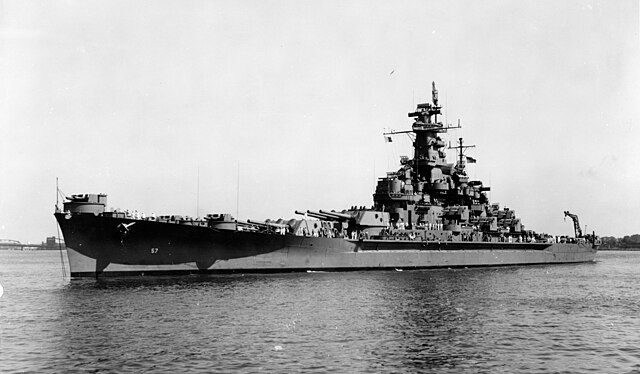 Photo: The U.S. Navy cargo ship USS Adhara (AK-71) off the Mare Island Naval Shipyard, California (USA), on 20 August 1943 Photo: The U.S. Navy cargo ship USS Adhara (AK-71) off the Mare Island Naval Shipyard, California (USA), on 20 August 1943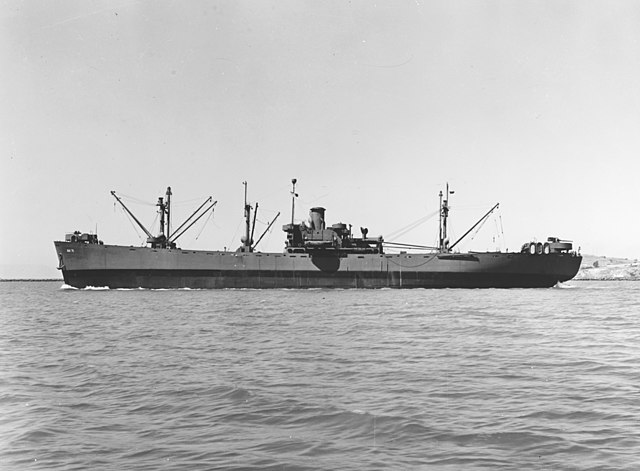 Pacific War Pacific WarCHINA-BURMA-INDIA Lieutenant General George E Stratemeyer assumes command of the US Army Air Forces, India-Burma Sector, China-Burma-India Theater which is activated at New Delhi, India. Components include the Tenth Air Force, CBI Air Service Command (Provisional), CBI Training Unit (Provisional) and several lesser units. Because of pressure from Chinese Generalissimo Chiang Kai-shek, Stratemeyer will only control the US Tenth Air Force in India and acts as an advisor to the Fourteenth Air Force in China which is commanded by Major General Claire L Chennault. BURMA-INDIA (Tenth Air Force): X Air Force Service Command (AFSC) personnel and organizations are absorbed by CBI ASC (Prov), see above. Brigadier General Robert C Oliver, Commanding General X AFSC, becomes Commanding General CBI ASC (Prov). CHINA (Fourteenth Air Force): In China, 6 B-25's, with fighter escort, bomb Tien Ho Airfield at Canton; they claim 5 interceptors shot down. 15 P-40's intercept 21 fighters over Kweilin; 2 P-40's and 2 Zekes are shot down. SOUTH PACIFIC THEATER OF OPERATIONS (Thirteenth Air Force): HQ XIII Bomber Command transfers from Espiritu Santo Island, New Hebrides Islands to Guadalcanal Island in the Solomon Islands. SOUTHWEST PACIFIC THEATER OF OPERATIONS (Fifth Air Force): 24 B-24's, escorted by 46 P-38's, hit Boram Airfield in the late morning; P-38's claim 19 fighters shot down. Force landed is B-24D "Joltin Janie II" 42-40233. A-20's bomb Lae and hit the Salamaua area where enemy forces have abandoned positions on Mount Tambu and Komiatum Ridge and are manning last-ditch defensive position at Salamaua. B-25's strafe barges near Cape Gloucester on New Britain Island. Lost is is P-38G 43-2201. NEW GUINEA CAMPAIGN This was part of phased brigade attacks ordered by Maj-Gen Savige (GOC 3 Aust Div) to break the Japanese defensive lines centered on Mt Tambu. Mt Tambu was an immensely strong natural fortress improved with fortifications up to 12 feet thick. The sequence was as follows: US 162nd Infantry Regiment(-) captured Roosevelt Ridge on 13 August; 15th Aust militia Brigade attacked Bobdubi Ridge on 14 August; 17th Brigade AIF enveloped Mt Tambu on 16 August. The capture of Mt Tambu was achieved by two companies of 2/6 Bbn AIF infiltrating across Buirali gorge to seize a position behind Mt Tambu, astride the Japanese supply line. At the same time frontal pressure was maintained by 2/5 Bn AIF and I/162 US Inf Bn. Japanese counter attacks on the 2/6 Bn infiltration force were broken up by long range sustained MG fire from 42 Aust militia Bn. After three days, the Japanese I/66 Bn abandoned Mt Tambu on 19 August. Neighbouring defensive positions were also abandoned. The Japanese had been evicted from a strong defensive position at minimal cost. PACIFIC Submarine Pompano (SS-181) departs Midway on her seventh war patrol. She is never heard from again. Destroyer Pringle (DD-477) is damaged by Japanese strafing and near-miss of bombs while transiting Gizo Strait, Solomons; tank landing ships LST-354 is damaged by near-misses of bombs, off Barakoma. Submarine Gar (SS-206) sinks Japanese transport Seizan Maru, 01°00'N, 119°00'E. Submarine Plunger (SS-179) sinks Japanese merchant cargo ship Seitai Maru off the southwest coast of Hokkaido, 42°15'N, 139°58'E. Submarine Wahoo (SS-238) sinks Japanese merchant sampan No.1 Inari Maru, 45°50'N, 146°22'E. Dutch submarine O 24 sinks Japanese gunboat Chosa Maru south of Penang, Malaya, 05°09'N, 100°10'E.
|
|
lordroel
Administrator
Posts: 68,081 
Likes: 49,471
|
Post by lordroel on Aug 21, 2022 6:48:08 GMT
Day 1438 of World War II, August 21st 1943
Eastern Front
Soviet forces captured Zmiev, south of Kharkov. Field Marshal von Manstein warned Adolf Hitler that the Soviet Army's crunching offensives may overwhelm out-numbered German forces in the Ukraine. Wehrmacht intelligence determined 287 Soviet divisions were battering 52 German divisions.
Battle of the Atlantic
'U-134' was attacked by Wildcat and Avenger aircraft from the escort-carrier USS 'Croatan' escorting convoy UGS 14. The boat escaped.
Battle of the Mediterranean
US Ninth Air Force B-24s attacked a railroad station, marshalling yard, and air depot at Cancello Arnone. US Northwest African Strategic Air Force (NASAF) B-26 Marauders and B-17s bombed marshalling yards at Villa Literno and Aversa. The P-38 escort also attacked Aversa. NASAF aircraft claim 20+ enemy fighters shot down. NATAF fighter-bombers hit traffic on the Bovalino-Bagnara road.
The 'Lily' was sunk by 'U-596' with eight shells from her deck gun about 20 miles north-northwest of Beirut. At 12.42 hours, the 'Panikos' was sunk by 'U-596' with 25 rounds from the deck gun. And at 15.00 hours the 'Namaz' was sunk by 'U-596' with 13 rounds from the deck gun.
North Africa
In Algeria, Maj. André Gilbert Kempster (b.1916), Duke of Wellington's Regiment, threw himself on a grenade which had rolled into his trench - he died instantly.
German occupied Denmark
Riots, strikes and sabotage paralyzed Copenhagen and other Danish cities and towns. The Germans rushed 40,000 troops from Norway to quell the disturbances.
Pacific War
CHINA
(Fourteenth Air Force): In China, 14 B-24's, 7 B-25's, and 11 P-40's attack docks and the airfield at Hankow; a large force of fighters,
estimated at 50+, attacks the B-24 formation, shooting down 2 of the B-24's; gunners on the B-24's claim 40+ fighters shot down. In the Hengyang area, 19 P-40's battle 33 airplanes, shooting down 5 Zekes. S of Changsha, 9 P-38's clash with 12 Zekes, shooting down 3.
SOUTH PACIFIC THEATER OF OPERATIONS
(Thirteenth Air Force): B-25's and fighters strafe barges in Doveli Cove and Marquana and Paraso Bays in the Central Solomons.
SOUTHWEST PACIFIC THEATER OF OPERATIONS
(Fifth Air Force): B-25's attack But Airfield and Dagua Airfield, with close escort by sixteen P-38s of the 80th FS. There were scattered clouds over the target and an overcast en route over the mountains. The formation was attacked by between 20 and 40 Ki-43 Oscars about 15 miles south of Dagua, eleven of which were claimed to have been shot down. Lost are P-38G piloted by Guttel, P-38 piloted by Feehan and P-38G piloted by Krisher also P-38F 42-12637 ditched, pilot DeGraffenreid survived. Japanese sources indicate 25 fighters intercepted from 13th Sentai (mostly flying Type 1 fighters at this time), 59th Sentai and 68th Sentai, and seven were lost (another source lists 6 pilots killed: 2 from 68th Sentai and three from 13th Sentai and one from 59th Sentai). Japanese claims 11 plus 4 uncertain.
L2D Tabby is shot down over Bono Bay by 380th BG B-24 "Juarez Whistle".
B-17's bomb the Bogadjim area; and single B-24's hit the Salamaua area and targets of opportunity at Lahang. B-24's carry out a damaging strike against Pombelaa in the Celebes.
In Northeast New Guinea, Komiatum, 3.6 miles ESE of Salamaua, is captured by Australian troops. Meanwhile, B-25 Mitchells of the USAAF's 5th Air Force bomb But Airfield (But West) and Dagua Airfield (But East).
ALASKA
(Eleventh Air Force): During the Aleutian Campaign, 3 Jun 42 to 21 Aug 43, the Eleventh Air Force destroyed 69 aircraft, sank 21 and damaged 29 ships, and lost 29 of its own aircraft.
PACIFIC
Motor torpedo boats PT-181 and PT-183, operating from Rendova, are damaged by strafing of Japanese floatplane, northwest of Turovilu Island.
AUSTRALIA
Election returns in Australia show that Premier Curtin's Labor Party on top.
|
|
lordroel
Administrator
Posts: 68,081 
Likes: 49,471
|
Post by lordroel on Aug 22, 2022 5:53:27 GMT
Day 1439 of World War II, August 22nd 1943Eastern Front German forces, threatened with encirclement at Kharkov begin to withdraw from Kharkov. Manstein has persuaded Hitler to relax his "stand firm" policy. Air War over Europe12 Mosquitoes went to the Ruhr and 6 to Hamburg. 47 aircraft went minelaying in the Frisians and off Texel without loss. Albert Speer reported to Adolf Hitler on the damage to the rocket research facilities at Peenemünde. The extensive damage resulted in Germans moving the rocket testing to Poland, and production to central Germany. Hitler ordered that mass production of rockets be relocated to Blizna near Debice in Poland. The damaged buildings were successfully used as camoflage for continued work. An estimated two months of V-2 rocket output was lost, about 720 rockets, potentially saving 3600 lives. 257 Lancasters, 192 Halifaxes and 13 Mosquitoes attacked Leverkusen. 3 Lancasters and 2 Halifaxes were lost. Lancaster DV228 of 61 Sqdn, which had survived the Peenemunde raid, was one of the losses with the crew of P/O J.A. Spencer, Sgt S.J. Banting, Sgt R. Horwood, Sgt E. Johnson, Sgt J. Punter and Sgt T.F. Watkins. The I.G. Farben factory at Leverkusen was chosen as the aiming point for this raid and it was hoped that some of the bombs would hit this important place. But the raid was not successful. There was thick cloud over the target area and there was a partial failure of the Oboe signals. Bombs fell over a wide area. At least 12 other towns in and near the Ruhr recorded bomb damage. Dusseldorf was the hardest hit of these other places. 132 buildings were destroyed and 644 seriously damaged. Solingen reported 40 people killed and 65 injured. Only a few bombs fell in Leverkusen where 4 people were killed. The I.G.Farben factory received only superficial damage in the acid department. 5 Germans were injured in the factory and 1 foreign worker was killed. In an incident very similar to that of August 12th this year , yet another Hurricane operating from Milfield airfield, in Northumberland, crashed in a field at Kimmerston Farm, near Wooler at 17.00, owing to engine trouble. The aircraft damaged a fence on crashing and in turn suffered damage to its propeller and undercarriage. Short S.25 Sunderland Mk. III, s/n DD848 assigned to No. 201 Squadron based at Castle Archdale, County Fermanagh, Ireland, crashed on the lower slopes of Mount Brandon on the Dingle Peninsula in County Kerry at 0530 hours. This aircraft had taken off at 0330 hours in a flight of four Sunderlands to fly ASW patrols in the South Atlantic. The aircraft was flying off course, below the minimum safety altitude and in low clouds when it crashed. Three of the 11 crewmen aboard survived. The US VIII Air Support Command in England flew Missions 30A and 30B against 2 Luftwaffe airfields in France. 35 B-26B Marauders attacked Beaumont-le-Roger Airfield and 36 B-26's were dispatched to Nord Airfield at Poix. They all returned early when they were unable to contact the escort fighters, RAF Spitfires. A V-1 was fired from a He 111 for testing purpose and landed on the Danish island of Bornholm, northwest of Bodilsker church at 13:05 hours. The yellow painted V-1 touched down in a grass field and bounced across a small road to end up in a turnips field belonging to Klippedam farm. This was reported to the police in Nexø and Constable Johs. Hansen and Explosive expert Lt. Captain Hasager Christiansen prepared to drive to the location. Not until they were ready to go did Hansen inform the Wehrmacht as was his duty. This gave them a 15 minute advantage which was used to take several pictures of the V-1 and to put down a very detailed description in writing. By 15:00 hours the wreck had been removed by the Wehrmacht. This material was soon after sent to London via Sweden. Battle of the MediterraneanNorthwest African Strategic Air Force (NASAF) B-26s, with an escort of Northwest African Tactical Air Force (NATAF) A-36 Apaches, bombed the marshalling yard at Salerno, Italy; they claimed 26 enemy fighters destroyed. The German submarine 'U-458' was sunk southeast of Pantelleria, Italy, by depth charges from the RN destroyer HMS 'Easton' and the Greek destroyer HHMS 'Pindos'. 39 of the 47 U-boat crewmen survived. All fighter and medium bomber groups of the US Ninth Air Force were transferred to the US Twelfth Air Force. United StatesPhoto: the U.S. Navy training aircraft carrier USS Wolverine (IX-64) underway in Chicago harbor (USA), 22 August 1943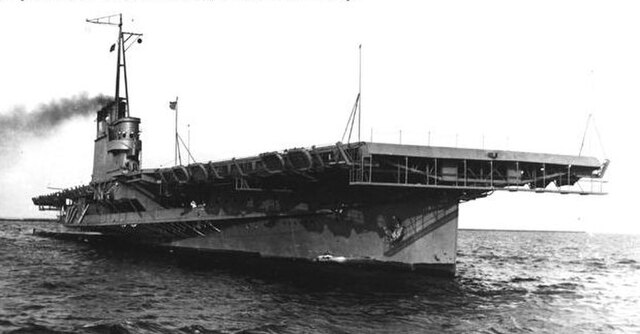 Pacific War Pacific WarCHINA (Fourteenth Air Force): In China, 4 P-40's bomb Japanese HQ and a supply dump at Tengchung, and strafe trucks and troops in the area; 2 others strafe road traffic between Tengchung and Lungling. The 12th Photographic Squadron, Fourteenth Air Force, transfers from Bishnupur, India to Kunming, China with F-5's. The flight which has been operating from Kweilin since Jul will remain there until Sep 43. SOUTH PACIFIC THEATER OF OPERATIONS (Thirteenth Air Force): B-25's and US Navy dive bombers, escorted by fighter aircraft, bomb barge centers on the W coast of Vella Lavella. SOUTHWEST PACIFIC THEATER OF OPERATIONS (Fifth Air Force): B-25's strike Dili. In New Guinea, as a result of the air offensive against Wewak and satellite airfields, Japanese airpower on New Guinea is sufficiently neutralized for 4 Allied destroyers to proceed along the coast from Milne Bay to Finschhafen; after bombarding Finschhafen during the night of 22/23 August, the warships return to Milne Bay. PACIFIC Marines (2d Airdrome Battalion) begin occupation of Nukufetau Atoll, Ellice Islands, as efforts proceed to acquire airfields to support the projected operations in the Marshalls and Gilberts. Submarine Pike (SS-173) damages Japanese army cargo ship Toun Maru, 21°22'N, 137°50'E. Submarine Plunger (SS-179) sinks Japanese merchant fishery mother ship Ryokai Maru, 42°40'N, 139°48'E. Submarine Swordfish (SS-193) sinks Japanese army cargo ship Nishiyama Maru off Palau, 02°53'N, 136°21'E . Submarine Tullibee (SS-284) sinks Japanese transport Kaisho Maru, 10°09'N, 147°25'E, and survives depth-charge attack by Ikazuchi.
|
|
lordroel
Administrator
Posts: 68,081 
Likes: 49,471
|
Post by lordroel on Aug 23, 2022 5:09:08 GMT
Day 1440 of World War II, August 23rd 1943Eastern Front Red Army forces entered Kharkov, the fourth, and last time the city would change hands in this war. The Germans attempted to launch a spoiling attack, but this was met by the newly reconstituted 5th Guards Tank Army and beaten back. Troops of General Konev's Steppe front took the city after Field Marshal von Manstein pulled his XI Corps out in defiance of Hitler's orders that Kharkov had to be held at all costs. Von Manstein had no alternative. His soldiers were about to be cut off by immensely superior Russian forces sweeping round the city, and he knew that the men of XI Corps were of more value to him than the shattered ruins of Kharkov. In the south, General Tolbhukin had broken the German line at the river Mius and was driving for the Donets bason with the aim of recovering the area's mineral riches and cutting off the German forces still in the Crimea and the Kuban bridgehead. The Germans admitted that a "Soviet spring flood" was pouring through a gap smashed in their lines at Mius. The fall of the city effectively ended the Battle of Kursk. A massive 224-gun salute by the Red Army thundered out in Moscow in celebration of the recapture of the principal city of the Ukraine. Air War over EuropeThe Battle of Berlin: RAF bombers once again took to the night skies over Berlin. This was the opening of a new Bomber Command terror campaign which would come to be known as “The Battle of Berlin”. 335 Lancasters, 251 Halifaxes, 124 Stirlings and 17 Mosquitoes attacked Berlin, 56 aircraft were lost. The Mosquitoes were used to mark various points on the route to Berlin in order to help keep the Main Force on the correct track. A Master Bomber was used. He was Wing Commander K.H. Burns of RAF No.97 Squadron. Wing Commander Burns was blown out of his Lancaster when it was shot down near Berlin a week later and lost a hand. Bomber Command suffered its greatest loss of aircraft in one night so far in the war. The raid was only partially successful and was badly scattered but still managed to kill over 900 people. The Pathfinders were not able to identify the centre of Berlin by H2S and marked an area in the southern outskirts of the city. The Main Force arrived late and many aircraft cut a corner and approached from the south west instead of using the planned south south east approach. This resulted in more bombs falling in open country than would otherwise have been the case. The German defences, both flak and night fighters were extremely fierce. Much of the attack fell outside Berlin. 25 villages reported bombs with 6 people killed there and in the sparsely populated southern suburbs of the city. Despite this, Berlin reported the most serious raid of the war so far with a wide range of industrial, housing and public properties being hit. 2,611 individual buildings were destroyed or seriously damaged. The worst damage was in the residential areas of Lankwitz and Lichterfelde and the worst industrial damage was in Mariendorf and Marienfelde. These districts are all well south of the city centre. More industrial damage was caused in the Tempelhorf area, nearer the centre, and some of those bombs which actually hit the centre of the city fell by chance in the 'government quarter', where the Wilhelmstrasse was recorded as having not a building undamaged. 20 ships on the city's canals were sunk. Casualties in Berlin were heavy considering the relatively inaccurate bombing. 854 people were killed. 684 civilians, 60 service personnel, 6 air raid workers, 102 foreign workers (89 of them women) and 2 prisoners of war. 83 more civilians were classified as missing. The city officials who compiled the reports found out that this high death rate was caused by an unusually high proportion of the dead not having taken shelter, as ordered, in their allocated air raid shelters. With the first of the Berlin raids, the 'Wilde Sau' concept was fully realized. Every available night-fighter including all servicable 'Wilde Sau' fighter became airbourne to intercept the Berlin raiders. On the ground, searchlights brilliantly lit up the sky and gun batteries had been issued incandescent rockets to launch, providing even more illumination. With the raiders illuminated by all this, the night-fighters destroyed 56 of the attacking bombers. 40 Wellingtons went minelaying in the Frisians and off Lorient and St Nazaire without loss. Battle of the AtlanticThe 40th Escort Group, consisting of sloops HMS 'Landguard', 'Bideford', 'Hastings' and frigates HMS 'Exe', 'Moyola' and 'Waveney' were deployed on a U-boat hunt off Cape Ortegal. Light cruiser HMS 'Bermuda' covered the whole operation. On the 25th, the Canadian 5th Support Group, consisting of frigates HMS 'Nene', 'Tweed' and corvettes HMCS 'Calgary', 'Edmundston' and 'Snowberry' were deployed to relieve the 40th Escort Group. While this was in progress the ships were attacked by 14 Dornier Do-217's and 7 Ju-88's with the new German weapon, the Henschel Glider Bombs, (the "Hs293 A-1"). Designed by the German Professor Herbert Wagner. HMS 'Landguard' and 'Bideford' were the first of the Allied and RN ships to be attacked and damaged by them. Several sailors were injured on 'Bideford' and one sailor was killed. Battle of the Baltic SeaThe Soviet motor torpedo boat TK 94 sank the Finnish minelayer 'Riilahti' in the Baltic Sea. 24 men, including commander, Knight of the Mannerheim Cross, Lt.-Cdr Osmo Kivilinna were lost. Battle of the Mediterranean US Ninth Air Force B-24 Liberators hit a marshalling yard at Bari and Northwest African Strategic Air Force (NASAF) B-26 Marauders bombed the Battipaglia marshalling yard. CanadaQuebec, Canada: The "Quadrant" conference between Mr. Churchill, President Roosevelt and the Canadian prime minister, Mr. Mackenzie King, and their staffs ended with a decision to press for a "second front" against Germany in France. This invasion, to be codenamed "Overlord", would be the top priority. The communiqué issued today said that "the whole field of world operations" had been surveyed, and the "necessary decisions have been taken to provide for the forward action" of Allied forces. Mr. Churchill had favoured a number of operations, against Norway and in southern Europe by continuing the offensive in Italy; the Americans wanted a frontal assault in France. A study was to be made of a landing in southern France. There were also strategic differences over the conduct of the war in South-east Asia, where the US generals want to invade Burma, while Mr. Churchill wants to attack Sumatra. Again the Americans won the argument, although the new South-east Asia Command (SEAC) to direct operations in Burma would likely be headed by a Briton. Preparations for a new offensive in Burma would now proceed, along with a second campaign behind Japanese lines by Brigadier Wingate's Chindits. Britain also approved US plans for the next stages of the Pacific War. United States Photo: The U.S. Navy troop transport USS Wharton (AP-7) underway in San Francisco Bay, California (USA), 23 August 1943 Pacific War Pacific WarALASKA Photo: USS LST-478 and USS LST-20 unloading on the beach at Kiska Island, Alaska, 23 August 1943. Just visible In the distance is the Japanese cargo ship Nozina Maru, beached by the Japanese after bombing by American forces Photo: USS LST-481 unloading on the beach at Kiska, Alaska, 23 August 1943 Photo: USS LST-481 unloading on the beach at Kiska, Alaska, 23 August 1943 SOUTH PACIFIC THEATER OF OPERATIONS (Thirteenth Air Force): B-24's and P-39's strafe targets of opportunity on Wagina Island in the Solomon Islands. SOUTHWEST PACIFIC THEATER OF OPERATIONS (Fifth Air Force): B-24's bomb the town and airfield of Kendari on Celebes Island. B-25's hit targets in the Aroe Islands. In New Guinea, B-26's pound Kela; and B-25's hit Marawasa, Finschhafen, and Lillum Saun. Lost is P-38G piloted by Mathers. BURMA-INDIA (Tenth Air Force): B-25's fly low-level strike against Myitnge, Burma bridge, knocking out a center span and badly damaging 2 others. NEW GUINEA CAMPAIGN Tonight 4 US destroyers will bombard Finschhafen, New Guinea. They are supporting air ops against Wewak. Amplifying the above: The main 5 AF raids against Wewak were delivered on 17 and 18 August, so this shoot would have been too late to provide an effective diversion. Perhaps this bombardment was part of the deception plan designed to draw attention from the landing of 9th Division AIF at Lae on 4 Sep 43? CHINA In China, the Japanese bomb Chungking for the first time since 1941. JAPAN The Japanese General Staff decides to abandon the central Solomons and concentrate its forces in the northern islands of the archipelago, notably Bougainville. JAPANESE OCCUPIED PHILIPPINES Submarine Grayling (SS-209) delivers supplies to Filipino guerrilla forces on Panay. PACIFIC USN submarine USS Paddle sinks Italian merchant passenger/cargo ship SS Ada off Hamamatsu, Japan, in position 34.37N, 137.53E. Coastal minesweeper Crow (AMc-20) is sunk by erratic running friendly aircraft torpedo, Puget Sound, Washington. Japanese transport Heito Maru is sunk by Allied aircraft east of Car Nicobar.
|
|
lordroel
Administrator
Posts: 68,081 
Likes: 49,471
|
Post by lordroel on Aug 24, 2022 6:11:41 GMT
Day 1441 of World War II, August 24th 1943Air War over Europe6 Mosquitoes went to Berlin and 42 aircraft went minelaying off Brest and the Biscay ports without loss. The USAAF's VIII Air Support Command and VIII Bomber Command in England flew missions to France. US VIII Air Support Command Missions 33A and 33B: B-26B Marauders flew 2 diversions for the VIII Bomber Command B-17s. An air depot and airfields in France were targeted by the US VIII Bomber Command in Mission 86 Part I. 110 B-17s were dispatched to the Villacoublay Air Depot. 86 hit the target at 1800-1805 hours and claimed 1-0-1 Luftwaffe aircraft. 42 B-17s were dispatched to the Conches and Evreux/Fauville Airfields and a B-17 was lost. US VIII Bomber Command Mission 86 Part II had 85 B-17s, which had flown to North Africa after attacking Regensburg, Germany on 17 August, dispatched to the Merignac Airfield at Bordeaux. 58 hit the target at 1157-1200 hours and claimed 3-3-10 Luftwaffe aircraft. 3 B-17s were lost. Nine B-17s returned to North Africa after encountering difficulties. Battle of the AtlanticThe USAAF's Antisubmarine Command is redesignated I Bomber Command and reassigned to the First Air Force after the USAAF and USN reach an agreement under which the USAAF withdraws from antisubmarine operations. The USN accepts responsibility for all ASW operations in the Atlantic and the USAAF will transfer all aircraft engaged in this activity to the USN. Two German submarines were sunk. 'U-134' was sunk in the North Atlantic near Vigo, Spain by 6 depth charges from an RAF Wellington Mk XIV of No 179 Squadron based at Gibraltar. All 48 men on the U-boat were lost. 'U-185' was sunk in the mid-Atlantic, by depth charges from 3 USN TBF Avengers of Composite Squadron Thirteen (VC-13) in the escort aircraft carrier USS 'Core' (CV-13). 22 of the 51 crewmen in the U-boat survived. Battle of the MediterraneanNorthwest African Tactical Air Force (NATAF) fighter-bombers hit a railroad tunnel and a cruiser offshore at Sibari, tracks and buildings at Castrovillari, and the town area at Sibari. RAF Desert Air Force airplanes strafed motor transport north of Reggio di Calabria and provided withdrawal cover for the NATAF fighter-bombers. German planes bomb U.S. tanker Esso Providence off Port Augusta, Sicily; there are no fatalities among the ship's merchant and Armed Guard complement. GermanySS Chief Heinrich Himmler was promoted to Reichminister of the Interior by Hitler. Neurath resigned as Protector of Bohemia and Moravia with Frisch as his replacement. German occupied Denmark There were several bomb incidents in Copenhagen, Denmark and strikes in shipyards, courtesy of the Danish resistance. CanadaFirst Quebec Conference ends. President Roosevelt and Prime Minister Churchill agree to intensify the war against Japan without relaxing the effort against Germany in Europe, and to intensify the war against Italy. Additionally, steps will be taken to include the Russians to a greater degree in the western Allies and to recognize General Charles DeGaulle's French Committee of National Liberation as representative of the Free French. United StatesPhoto: The U.S. Navy destroyer USS Franks (DD-554) underway in Smith Cove, Washington (USA), on 24 August 1943, speed 4 knots Pacific War Pacific War JAPANESE OCCUPIED EAST INDIES Fifth Air Force B-25 Mitchells bomb Larat Island in the Tanimbar Islands of the Netherlands East Indies. NEW GUINEA CAMPAIGN In Northeast New Guinea, the Australian 3 Division is replaced by the 5 Division during the final phases of operations against Salamaua. This attack is really a feint; the main objective is Lae and the main body of Australian forces are approaching it from the interior of the island. In the air, USAAF Fifth Air Force B-24 Liberators bomb Wewak and Salamaua. In Papua New Guinea, U.S. forces continue their operations to capture Dot Inlet located northwest of Morobe. NEW HEBRIDES ISLANDS The Japanese submarine I-25 launches a "Glen" to reconnoiter Espiritu Santo Island. CHINA 7 B-24 Liberators and 6 B-25 Mitchells of the USAAF's Fourteenth Air Force, escorted by 22 P-40s and P-38 Lightnings, bomb airfields at Hankow and Wuchang; 4 B-24s are lost; 24 IJA interceptors are claimed shot down. SOLOMONS ISLAND CAMPAIGN - 25 Thirteenth Air Force B-24s, with fighter escort, bomb Papatura Fa Island and attack the eastern shore of Ringa Cove on New Georgia Island. P-39 Airacobras strafe barges at Kakasa on Choiseul Island. - The New Georgia campaign ends as U.S. Army troops occupy Bairoko Harbor. PACFIC Motor torpedo boats PT-175, PT-176, and PT-164, operating from Rendova, are damaged by Japanese floatplanes, Gizo Strait. Submarine Whale (SS-239) damages Japanese fleet tanker San Diego Maru, 31°30'N, 128°35'E. Small reconnaissance seaplane from Japanese submarine I-25 reconnoiters Espiritu Santo.
|
|
lordroel
Administrator
Posts: 68,081 
Likes: 49,471
|
Post by lordroel on Aug 25, 2022 5:30:23 GMT
Day 1442 of World War II, August 25th 1943
Eastern Front
Red Army forces pursued the retreating Germans occupying Zenkov and Akhtyrka, west and north of Kharkov.
Air War over Europe
The US Eighth Air Force was assigned to the role of bombing important Luftwaffe targets in Operation STARKEY, designed to contain enemy forces in the west to prevent their transfer to the Eastern Front, and to serve as a dress rehearsal in the Pas de Calais, France area for the invasion of western Europe. The Allies hoped to provoke the Luftwaffe into a prolonged air battle.
The US VIII Air Support Command flew Missions 34A and 34B against two targets in France. 21 B-26B Marauders bombed the power station at Rouen and 31 B-26s attacked Tricqueville Airfield. They claimed 1-8-5 Luftwaffe aircraft.
In a military first, the Germans test a new guided bomb, the Hs293, in the Bay of Biscay. The Canadian 5th Support Group, consisting of frigates HMS 'Nene', 'Tweed' and corvettes HMCS 'Calgary', 'Edmundston' and 'Snowberry' were deployed to relieve the 40th Escort Group. While this was in progress the ships were attacked at 1415 hours by 14 Dornier Do-217s of Hptm. Molinus' II./KG 100 and 7 Ju-88s with the new German weapon, the Henschel Glider Bombs, (the "Hs293 A-1"). Designed by the German Professor Herbert Wagner, the device, launched from a bomber, was guided by radio signal from an airborne observer to the target. HMS 'Landguard' and 'Bideford' were the first of the Allied and RN ships to be attacked and damaged by them. Several sailors were injured on 'Bideford' and one sailor was killed. The initial test failed to hit the ship, but the system did show great promise.
32 aircraft went minelaying off Brest and the Biscay ports without loss.
Battle of the Atlantic
German submarine 'U-523' was sunk west of Vigo, by depth charges from the RN destroyer HMS 'Wanderer' and the corvette HMS 'Wallflower'. 37 of the 54-man crew of the U-boat survived. 'U-340' rescued 5 Luftwaffe airmen off Spain. Shortly afterwards the boat was attacked by an aircraft and a few men were wounded, the boat being damaged.
German warships attack and sink two Swedish trawlers in Danish waters.
Battle of the Mediterranean
US Ninth Air Force B-24s bombed the marshalling yard at Foggia while about 135 Northwest African Strategic Air Force B-17 Flying Fortresses and 140 P-38 Lightnings attacked satellite airfields at Foggia. The P-38s of the US 1st FG swept in on a low level attack and destroyed 43 Ju 88s, 1 Ju 52 and 1 Bf 109 along with dozens of others damaged for the loss of two Lightnings to flak. Unwilling to expose their aircraft and pilots to the free ranging Lightnings, the Luftwaffe found itself on the ground at Foggia when another 136 B-17s with P-38 escort blasted the complex into ruin. As many as 47 aircraft were destroyed on the ground. Major Johannes Steinhoff of Stab./JG 77, intercepting the Allied force, accounted for 4 P-38s destroyed while 3 B-17s fell to pilots from JG 53 and JG 3.
Arctic naval operations
The Soviet 'Shkval' (Senior-Lt V.S. Timofeev) struck two mines laid on 12 August by 'U-625' in the east part of the Yugorskij Shar Strait in the Kara Sea and sank immediately. The ship provided a transfer of river ships from Pechora to Ob´ river.
Germany
The Arado 234 V3 jet bomber made its first flight. This aircraft had a pressurized cabin, an ejector seat and RATOG (Rocket Assisted Take-Off Gear).
Pacific War
CHINA
(Fourteenth Air Force): 8 B-25's, with fighter escort, bomb Kowloon Docks at Hong Kong.
SOUTH PACIFIC THEATER OF OPERATIONS
(Thirteenth Air Force): 13 B-25's, along with 40+ US Navy dive bombers and an escort of fighter aircraft, pound barge centers at Webster and Ringa Coves on New Georgia Island. 6 B-24's, along with 24 fighters, hit Kahili Airfield. Other P-40's strafe large motor vessels and a barge in the NW part of the Slot. The 371st Bombardment Squadron (Heavy), 307th Bombardment Group (Heavy), based on Espiritu Santo in the New Hebrides Islands begins operating from Guadalcanal Island with B-24's; they will fly their first mission tomorrow.
SOUTHWEST PACIFIC THEATER OF OPERATIONS
(Fifth Air Force): In New Guinea, almost 100 B-24's, B-25's, and B-17's carry out an hour-long strike against the Hansa Bay area, Nubia, and Awar, and nearby shipping; and small flights of B-24's attack Finschhafen and hit a transport off New Hanover Island in the Bismarck Archipelago. A-20's hit Gasmata; and B-25's bomb targets on Timor Island. HQ 433d Troop Carrier Group arrives at Port Moresby, New Guinea from the US. They will remain at this station until Oct 44.
PACIFIC
Rear Admiral Marc A. Mitscher is relieved as Commander Aircraft, Solomons, by Major General Nathan F. Twining, USA.
Admiral Louis F Mountbatten is appointed Supreme Allied Commander, Southeast Asia.
TG 34.4, covered by four destroyers, sows mines off Wilson Cove, western Kolombongara; light minelayers Montgomery (DM-17) and Preble (DM-20) are damaged in collision as they retire from the area, 09°01'S, 159°50'E.
Destroyer Patterson (DD-392) sinks Japanese submarine RO 35, 170 miles southeast of San Cristobal Island, Solomons, 12°57'S, 164°23'E.
USAAF B-24 damages Japanese vessel Mito Maru 60 miles west-northwest of Mussau Island.
|
|
lordroel
Administrator
Posts: 68,081 
Likes: 49,471
|
Post by lordroel on Aug 26, 2022 5:18:20 GMT
Day 1443 of World War II, August 26th 1943Air War over Europe HQ 67th Fighter Wing arrives at Walcot Hall, England from the US. The wing will remain at this station until Oct 45. HQ 20th Fighter Group arrives at Kings Cliffe, England from the US. The group will remain at this station until Oct 45. The 359th and 360th Fighter Squadrons, 356th Fighter Group, arrive at Goxhill, England from the US with P-47's. The US VIII Air Support Command Mission 35: 36 B-26's are dispatched to Caen/Carpiquet Airfield, France; all hit the target at 1846 hours; 1 B-26 is damaged beyond repair when it crashes on landing. Photo: Lancaster B Mark Is of No. 50 Squadron, Royal Air Force, based at Skellingthorpe, flying in spread formation. The two aircraft beyond the wing tip are `VN-D' and `VN-J' the former, serial number JA899, was missing on the night of 24 - 25 June 1944 with Pilot Officer L G Peters and crew Battle of the Mediterranean Battle of the MediterraneanThe RAF's Desert Air Force (DAF) was assigned to the Northwest African Tactical Air Force (NATAF), along with US units of the Ninth Air Force which have been an operational part of DAF and Northwest African Tactical Bomber Force (NATBF). 80+ Northwest African Strategic Air Force (NASAF) B-17s, with P-38 escort, bombed Capua Airfield and 100+ fighter-escorted medium bombers hit Grazzanise Airfield and satellite field. At 22.16 hours, 'U-410' fired a spread of three torpedoes at the convoy UGS-14 off La Calle, Algeria, heard three hits and reported two ships sunk and another damaged. In fact, the 'John Bell' and 'Richard Henderson' were sunk. The 'John Bell' (Master David Dunlap Higbee) had been in station #52, but changed the to station #32 in the afternoon as the convoy was reformed into four columns to pass through minefields. The ship was struck by one torpedo on the starboard side between the #4 and #5 holds in a compartment with aviation gasoline. The explosion ignited the cargo, the flames rose 25 feet above the holds and spread rapidly aft and slowly forward. The most of the eight officers, 35 crewmen and 29 armed guards (the ship was armed with two 3in and eight 20mm guns) abandoned ship immediately in five of the six lifeboats. But five armed guards on the stern had to jump overboard and swam to the boats. The ship was soon ablaze from stem to stern and burned for nine hours before sinking stern first. The survivors were picked up within 45 minutes by the British minesweeper HMS BYMS-23 and the South African armed whaler HMSAS 'Southern Maid' (T 27) and landed at Bizerte on 27 August. The only casualty was an oiler who had been trapped in the shaft alley. The 'Richard Henderson' (Master Lawrence Joseph Silk) had been in station #43, but changed to station #22 in the afternoon as the convoy was reformed into four columns to pass through minefields. The ship was struck by one torpedo on the starboard side, aft of the #5 hatch. The explosion destroyed the quarters of the gun crew, blew away the rudder and screw and flooded the engine room. As the vessel began to settle slowly by the stern, the engines were secured and the eight officers, 34 crewmen and 28 armed guards (the ship was armed with two 3in and eight 20mm guns) abandoned ship in six lifeboats. The ship sank by the stern after five hours. The next morning, three lifeboats made landfall at La Calle, Algeria. The remaining survivors in the other three boats were rescued by escort ships, among them the South African armed trawler HMSAS 'Southern Maid' (T 27) and landed on 27 August at Bizerte, Tunisia. Battle of the Baltic SeaSoviet submarine SC-203 was sunk near Cape Uret in the Baltic Sea by a torpedo from Italian submarine SB.4. All hands were lost. GermanyStalag 383, Bavaria: Two British prisoners made a daring escape from this camp yesterday by walking out of the gate wearing home-made German uniforms and carrying forged passes. The escapers, Lance-Sergeant Suggit of the 5th (Inniskilling) Dragoon Guards and Sergeant Beeson of the RAOC, had to bring their attempt forward a day because there was so much activity, masterminded by the escape committee, that their original plan would have clashed with an attempt by others to "go over the wire". They made their German uniforms from Australian tunics dyed green with dyes acquired from the camp theatre. Their badges were made of cardboard covered in silver paper, and their medal ribbons cut out of tin coloured with red and black ink. A friendly guard from Alsace lent them his papers so that they could be forged. At dusk tonight, with sandwiches in their fake holsters, they walked nonchalantly out of the gate. United KingdomPhoto: HMS Submarine Unbroken Returns To Portsmouth, 26 August 1943 - Ratings on shore watch the Unbroken as she enters Portsmouth harbour United StatesPhoto: The French battleship Richelieu underway in the Atlantic Ocean on 26 August 1943, after her refit at the New York Naval Shipyard (USA) United StatesPhoto: The French battleship Richelieu underway in the Atlantic Ocean on 26 August 1943, after her refit at the New York Naval Shipyard (USA)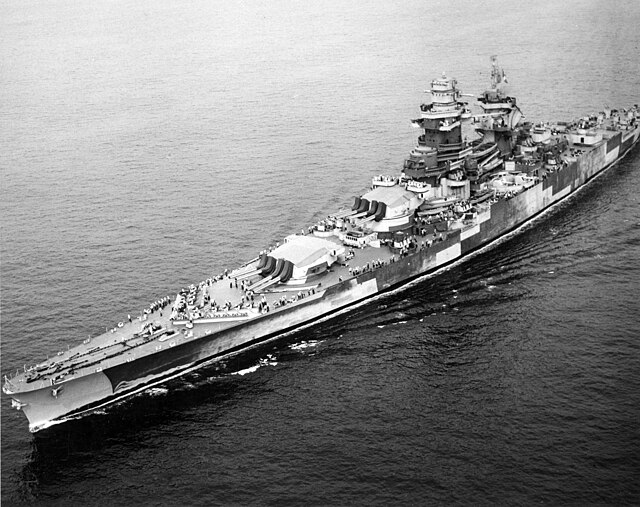 Pacific War Pacific WarCHINA (Fourteenth Air Force): 15 B-24's, with an escort of 17 fighters, bomb Kowloon Docks at Hong Kong; 5 Japanese interceptors are shot down. 5 B-25's, supported by 11 P-40's, bomb Tien Ho Airfield at Canton, China; in a battle with enemy interceptors 1 P-40 is lost; the B-25's and P-40's claim 5 Zekes downed. In China, the 449th Fighter Squadron is activated at Kunming and is assigned to the 51st Fighter Group. The squadron forms at Lingling and begins training with P-38's. SOUTH PACIFIC THEATER OF OPERATIONS (Thirteenth Air Force): In the Solomon Islands, 11 B-25's and 50+ US Navy dive bombers, escorted by fighters, pound AA positions and barges at Ringa and Webster Coves on New Georgia Island and at Nusatuva Island; P-40's strafe 2 large motor boats and a 100-foot (30.5 m) steam vessel off Ganongga Island; 15 B-24's bomb Papatura Ite and supply areas on Papatura Fa Island; 15 B-24's, with fighter escort, bomb Kahili Airfield; and P-39's strafe buildings at Gizo and at Kolulavabae Inlet. ALASKA (Eleventh Air Force): In the Aleutian Islands, the Eleventh Air Force's striking power shrinks rapidly as the the following squadrons are ordered to prepare for departure to the Zone of Interior (ZI): 21st Bombardment Squadron, 30th BG (Heavy), on Umnak Island with B-24's, 36th Bombardment Squadron, 28th Composite Group, on Amchitka Island with B-24's, 73d BS (Medium), 28th Composite Group, on Amchitka Island with B-25's, and 406th Bombardment Squadron, 41st BG (Medium), at Elmendorf Field, Anchorage, with B-25's. PACIFIC Submarine Tunny (SS-282) attacks Japanese convoy consisting of transport Amagisan Maru and oiler (ex-seaplane carrier) Tsurumi, escorted by submarine chaser Ch 4, off Palaus, 07°30'N, 134°20'E; Tunny's attack is unsuccessful but Ch 4 damages the submarine and forces her to terminate her patrol. USAAF B-24s bomb Japanese destroyers attempting to reach Buin, 45 miles from Buka, damaging Hamakaze and forcing her to put into Rabaul for repairs.
|
|
lordroel
Administrator
Posts: 68,081 
Likes: 49,471
|
Post by lordroel on Aug 27, 2022 5:39:13 GMT
Day 1444 of World War II, August 27th 1943YouTube (Kharkov Changes Hands for the Fourth Time)Eastern FrontThe Soviet offensive contiued as the Central Front took Sevsk and Vatutin’s forces took Kotleva. Field Marshal von Manstein told Adolf Hitler that his Army Group South can't hold off the Soviet offensives in southern Russia and Ukraine. He urged falling back to the Dnieper, the largest river in the western Soviet Union. Hitler insisted the Donets area must be held. Air War over Europe 349 Lancasters, 221 Halifaxes and 104 Stirlings attacked Nuremberg, 33 aircraft lost. The marking for this raid was based mainly on H2S. 47 of the Pathfinder H2S aircraft were ordered to check their equipment by dropping a 1,000 lb bomb on Heilbronn while flying to Nuremberg. 28 Pathfinder aircraft were able to carry out this order. Heilbronn reported that several bombs did drop in the north of the town soon after midnight. The local officials assumed that the bombs were aimed at the industrial zone. Several bombs did fall around the factory area and other bombs fell further away. No industrial buildings were hit. One house was destroyed but there were no casualties. Nuremberg was found to be free of cloud but it was very dark. The initial Pathfinder markers were accurate but a creepback quickly developed which could not be stopped because so many Pathfinder aircraft had difficulties with their H2S sets. The Master Bomber, whose name is not recorded, could do little to persuade the Main Force to move their bombing forward. Only a quarter of the crews could hear his broadcasts. Bomber Command estimated that most of the bombing fell in open country south-south-west of the city but the local reports said that bombs were scattered across the south-eastern and eastern suburbs. The only location mentioned by name was the Zoo which was hit by several bombs. 65 people were killed. An RAF Coastal Command Liberator Mk. V, RAF s/n BZ802, aircraft "V" of No. 86 Squadron based at Aldergrove, County Antrim, Ireland, crashed at Kilmacown, County Cork in poor weather. Seven crewmen were killed. The last Westland Wallace (K 4344) biplane target-tug was 'struck off charge' by the RAF. The 77th and 79th Fighter Squadrons, 20th Fighter Group, arrive at Kings Cliffe, England from the US with P-38's. The squadrons will fly their first mission on 28 Dec 43. US VIII Bomber Command Mission 87: 224 B-17s were dispatched to the German rocket-launching site construction at Watten, France and lost 4 B-17s. The bombers thoroughly destroyed the site. The mission escort consisted of 173 P-47s and they claimed 8-1-2 Luftwaffe aircraft. 1 P-47 was lost and the pilot was listed as MIA. This was the first of the Eighth Air Force's missions against V-weapon sites (later designated NOBALL targets). US VIII Air Support Command Missions 36A - 36B: Two missions were scheduled to targets in France. 36 B-26s were dispatched to the Poix Nord Airfield and 21 B-26s were dispatched to the Rouen Power Station but the mission was aborted because of bad weather and extremely heavy enemy fighter opposition. 47 aircraft went minelaying in the Frisians and off La Pallice, Lorient and St Nazaire, 1 aircraft was lost. Ex French president Lebrun was arrested by the Gestapo. Lebrun deferred to the National Assembly's 10 July 1940 vote approving Marshal Henri Petain as head of state and then he retired to Vizille in the Italian zone of occupation. He was arrested after the Germans moved in and deported to Austria from 1943 to 1945. He survived the war and met with de Gaulle shortly after the war ended to acknowledge the General's leadership. A second operation using the new Luftwaffe guided missle weapon brought a better result that the first operation on 25 August. Sloop HMS 'Egret', HMCS 'Athabaskan', a Tribal-class destroyer, Capt. G.R. Miles, OBE, RCN, in company with three other British warships, was attacked in the Bay of Biscay by 16 German Dornier Do-217 bombers from II./KG 100, each carrying one HS-293 radio-controlled bomb. HMS 'Egret', the name ship of her class of sloops, was hit. When the smoke of the initial explosion cleared, all that could be seen of 'Egret' was her upside down bow section. 'Egret' was thus the first ship to be sunk by a guided missile. Three missiles were launched at 'Athabaskan'. Two were near misses - one missed astern and the other skimmed over the bridge and landed to starboard. The third hit the port side abaft ‘B-turret’, flew straight through the wheelhouse and the CPO’s Mess, exited the starboard side and exploded after hitting the water. There was extensive damage from the missile, exploding cordite in the gun house, and shrapnel. Amazingly, only four men were killed and another 36 were wounded. 'Athabaskan' was dead in the water for about two hours. She was transferred the survivors from 'Egret' and detached for Plymouth, which she reached under her own power on 30 August after a very difficult voyage. Two German Do-217s were shot down and another was damaged in this engagement. 'Athabaskan' was under repair until 01 Jan 44. HM ships 'Grenville', the flotilla leader for the U-class fleet destroyers, 'Rother' and 'Jed', both River-class frigates, were undamaged in the engagement. Battle of the AtlanticUSN Composite Squadron One (VC-1) in the escort aircraft carrier USS 'Card' (CVE-11) has a busy day with German submarines. TBF Avengers and F4F Wildcats attacked 'U-508' but the sub escaped. Later, they sank 'U-847' in the Sargasso Sea, by air-launched (Fido) torpedoes. All hands, 62 men, on the U-boat were lost. 'U-354' fired a single torpedo at a Soviet convoy consisting of four merchants and two patrol boats and heard a detonation after 1 minute 55 seconds and two further detonations five minutes after firing a spread of three torpedoes at 20.22 hours. The U-boat saw after the attack only two merchants and one escort and claimed the sinking of two ships. In fact, the 'Petrovskij' was only damaged. Battle of the AtlanticUSN Composite Squadron One (VC-1) in the escort aircraft carrier USS 'Card' (CVE-11) has a busy day with German submarines. TBF Avengers and F4F Wildcats attacked 'U-508' but the sub escaped. Later, they sank 'U-847' in the Sargasso Sea, by air-launched (Fido) torpedoes. All hands, 62 men, on the U-boat were lost. Arctic naval operations'U-354' fired a single torpedo at a Soviet convoy consisting of four merchants and two patrol boats and heard a detonation after 1 minute 55 seconds and two further detonations five minutes after firing a spread of three torpedoes at 20.22 hours. The U-boat saw after the attack only two merchants and one escort and claimed the sinking of two ships. In fact, the 'Petrovskij' was only damaged. Battle of the MediterraneanIn Italy, Northwest African Strategic Air Force (NASAF) B-17s bombed the Sulmona marshalling yard, and medium bombers hit the Benevento and Caserta marshalling yards. Nearly 150 P-38s escorted the bombers. Northwest African Tactical Air Force (NATAF) medium and light bombers, and fighters attacked targets in S Italy, including Cantanzaro rail and road junction, guns near Reggio di Calabria, Sibari rail junctions, Cetraro marshalling yard, barracks at Tarsia, train and repair shops at Paola, and a barge at Diamante. Fighting broke out between the Germans and elements of the Italian 15th Corps in Ljubljana, Slovenia after the Italians refused to withdraw from the city. A British reconnaissance group found the toe of the Italian boot had been deserted by German and Italian forces and was open for invasion. The Badoglio government secretly moved former dictator Benito Mussolini to a mountaintop resort in the Apennine mountains 70 miles (112.7 kilometres) east of Rome. For the past month, Mussolini's guards moved him from place to place to foil German rescue schemes. Battle of the Indian OceanLast group of survivors from U.S. freighter Robert Bacon, torpedoed and sunk by German submarine U-178 on 14 July 1943 off Mozambique Light, reaches safety after 44 days at sea. Only one survivor perishes from exposure. United StatesPhoto: The U.S. Navy light aircraft carrier USS Cabot (CVL-28) off the Philadelphia Navy Yard, Pennsylvania (USA), on 27 August 1943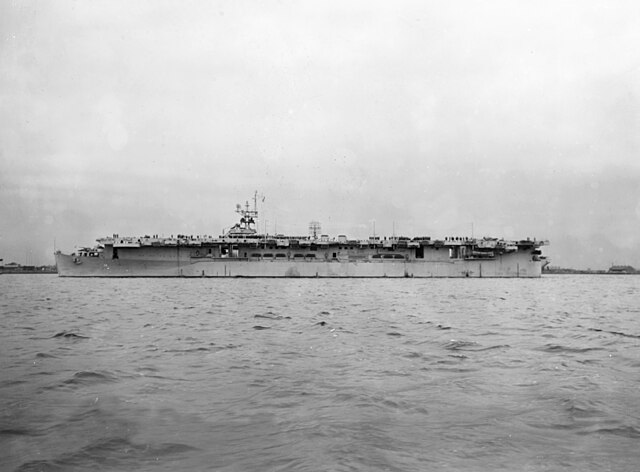 Photo: The French battleship Richelieu underway in the Atlantic Ocean on 27 August 1943, after her refit at the New York Naval Shipyard (USA) Photo: The French battleship Richelieu underway in the Atlantic Ocean on 27 August 1943, after her refit at the New York Naval Shipyard (USA) Pacific War Pacific WarCHINA (Fourteenth Air Force): In China, 5 P-40's strafe a large truck convoy between Sintsiang and Yoyang, destroying 5 trucks and damaging 15 others; 1 P-40 is downed by ground fire; 6 other P-40's hit communication lines between Yoyang and Hankow; targets include 2 small steamboats, a gunboat, several railroad cars, and a water tower. SOUTH PACIFIC THEATER OF OPERATIONS (Thirteenth Air Force): 10 B-24's Snoopers equipped with radar devices that permit blind bombing, begin operations from Carney Field, Guadalcanal Island. 12 B-25's, 8 P-40's, and 8 US Navy F4U's strafe barges and shoreline targets at Kakasa on Choiseul Island; and P-39's strafe barges and shore targets at Ringa Cove on New Georgia Island. Ten USAAF Thirteenth Air Force B-24 Snoopers, i.e., B-24s Liberators equipped with radar devices that permit blind bombing, begin operations from Carney Field, Guadalcanal. Twelve B-25s, 8 P-40s, and 8 USMC F4U Corsairs strafe barges and shoreline targets at Kakasa on Choiseul Island; and P-39 Airacobras strafe barges and shore targets at Ringa Cove on New Georgia Island. The USN's Fighting Squadron VF-33, equipped with F6F-3 Hellcats, lands on Guadalcanal for shore-based duty. These are the first F6Fs deployed to the war zone. SOUTHWEST PACIFIC THEATER OF OPERATIONS (Fifth Air Force): B-26's attack bridges in the Bogadjim area; and A-20's strafe barges and troops along the Babui River in the Lae area. On Timor Island, B-25's bomb Dili and Cape Chater airstrip. The 67th Troop Carrier Squadron, 433d Troop Carrier Group, arrives at Port Moresby, New Guinea from the US with C-47's. NEW GEORGIA CAMPAIGN The U.S. 172d Infantry Regiment of the 43d Infantry Division lands on Arundel Island off the northwest tip of New Georgia Island. The regiment meets determined opposition by the Japanese. Map: Actions in western New Georgia PACIFIC Army troops (RCT 172 of 43d Infantry Division) are landed on Arundel Island, Solomons. Submarine Drum (SS-228) damages Japanese transport Yamagiri Maru, 01°31'S, 148°41'E. Submarine Grayling (SS-209) sinks Japanese army cargo ship Meizan Maru, 13°35'N, 120°45'E. Submarine Pollock (SS-180) sinks Japanese army cargo ship Taifuku Maru, 32°28'N, 132°23'E, although minesweeper W.17 arrives on the scene in time to open fire on Pollock, the submarine escapes. Submarine Snapper (SS-185) inflicts further damage on the previously damaged Japanese transport Tokai Maru (see 26 January and 5 May 1943), Apra Harbor, Guam, 13°31'N, 144°37'E. USAAF B-17s and B-24s, escorted by P-38s, bomb Japanese installations in the Hansa Bay area, damaging small cargo vessel No.8 Manryu Maru. USAAF B-24s bomb Japanese shipping off western tip of New Hanover, damaging army cargo ship No.18 Shinsei Maru. USAAF B-25s bomb Japanese shipping and installations at Choiseul, damaging fishing vessel Kokusei Maru.
|
|
lordroel
Administrator
Posts: 68,081 
Likes: 49,471
|
Post by lordroel on Aug 28, 2022 6:07:24 GMT
Day 1445 of World War II, August 28th 1943Eastern FrontRed Army forces captured Lyubotin. Taganrog on the Sea of Azov was evacuated by German troops. Air War over EuropeUS Eighth Air Force Major General William E Kepner succeeded Major General Frank O Hunter as Commanding General US VIII Fighter Command. Battle of the Mediterranean Northwest African Strategic Air Force B-17s hit the Orte marshalling yard, and B-26s bombed Torre Annunziata. Northwest African Tactical Air Force fighters escorted the NASAF bombers, hit a rail junction at Bagnara, bridge and town of Angitola, gun positions in the Villa San Giovanni-Reggio di Calabria areas, and a marshalling yard at Lamezia. Battle of the Black Sea'U-18' fired one torpedo at the TSC-11 'Dzhalita', observed a hit under the aft mast after 1 minute 55 seconds and further detonations as the ship sank quickly by the stern about 25 miles northwest of Poti. The survivors were picked up by the Soviet coastal minesweeper SKA-0108. United StatesThe formation of USN combat units for the employment of assault drone aircraft began within the Training Task Force Command as the first of three Special Task Air Groups was established. The component squadrons, designated VK, began establishing on 23 October. Photo: The U.S. Navy destroyer USS Bulmer (DD-222) underway off the Mare Island Navy Yard, California (USA), on 28 August 1943. Note the barrage balloons in the distance Pacific War Pacific WarCHINA (Fourteenth Air Force): In China, 5 P-40's strafe a large truck convoy between Sintsiang and Yoyang, destroying 5 trucks and damaging 15 others; 1 P-40 is downed by ground fire; 6 other P-40's hit communication lines between Yoyang and Hankow; targets include 2 small steamboats, a gunboat, several railroad cars, and a water tower. SOUTH PACIFIC THEATER OF OPERATIONS (Thirteenth Air Force): In the Solomon Islands, B-25's, P-40's, and US Navy F4U's bomb and strafe barges, buildings, and personnel in the Sigolehe Island-Barora Ite Island area. SOUTHWEST PACIFIC THEATER OF OPERATIONS (Fifth Air Force): 26 B-25's bomb and strafe dumps and shipping in the Hansa Bay area, sinking a small freighter, a power launch, and 8 barges and luggers. Lost is B-25D "Reluctant Dragon" 41-30345; and 20 B-17's and A-20's bomb jetties at Lae and Voco Point and hit barges in Samoa Harbor between Lae and Salamaua. P-47 Thunderbolt force lands at Redscar Beach. ELLICE ISLANDS Elements of two USN Seabee battalions and the 7th Marine Defense Battalion land on Nonomea Island, only 400-miles from the Japanese-held Gilbert Islands. Work immediately begins on an airfield. PACIFIC Submarine Tarpon (SS-175) damages Japanese stores ship Shinsei Maru, 33°39'N, 138°28'E. Navy PBY aircraft attacks Japanese minelayer Hoko off Buka; although the Catalina crew claims damage, the enemy auxiliary escapes unscathed. USAAF B-25 and P-38 aircraft bomb Japanese installations in Hansa Bay region, sinking fishing vessels Owaru Maru and Seio Maru.
|
|
lordroel
Administrator
Posts: 68,081 
Likes: 49,471
|
Post by lordroel on Aug 29, 2022 6:18:26 GMT
Day 1446 of World War II, August 29th 1943Air War over Europe4 Oboe Mosquitoes went to Cologne and 4 to Duisburg, 1 aircraft lost. Battle of the AtlanticGerman auxiliary cruiser Michel (Schiffe 28) eludes light cruiser Trenton (CL-11) off the coast of Chile. German occupied DenmarkThe Danish government of Prime Minister Erik Scavenius, resigned and the Danish Army was disbanded after the Danes refused to yield to a German demand that saboteurs be executed. General von Hanneken declared marshal law and moved in 50,000 troops as sporadic fighting was reported. Most of the Danish fleet was scuttled, preventing its capture by the Germans. 1 coast defence ship, 9 submarines, a tender, 3 minesweepers and 4 minelayers, were scuttled at Copenhagen and a coast defence ship was scuttled at Isefjord. A patrol boat, 3 motor minesweepers and 9 small auxiliary vessels sortied to Sweden; the German captured 3 minesweepers and 2 patrol boats. Photo: Danish officers are detained on 29 August 194 Photo: Germans on patrol at Højbro Plads following the declaration of martial law, 29 August 1943 Photo: Germans on patrol at Højbro Plads following the declaration of martial law, 29 August 1943 Photo: Danish Ships sunk, 28 August 1943 Photo: Danish Ships sunk, 28 August 1943 Photo: Niels Juel attacked by German aircraft on 29 August 1943 Photo: Niels Juel attacked by German aircraft on 29 August 1943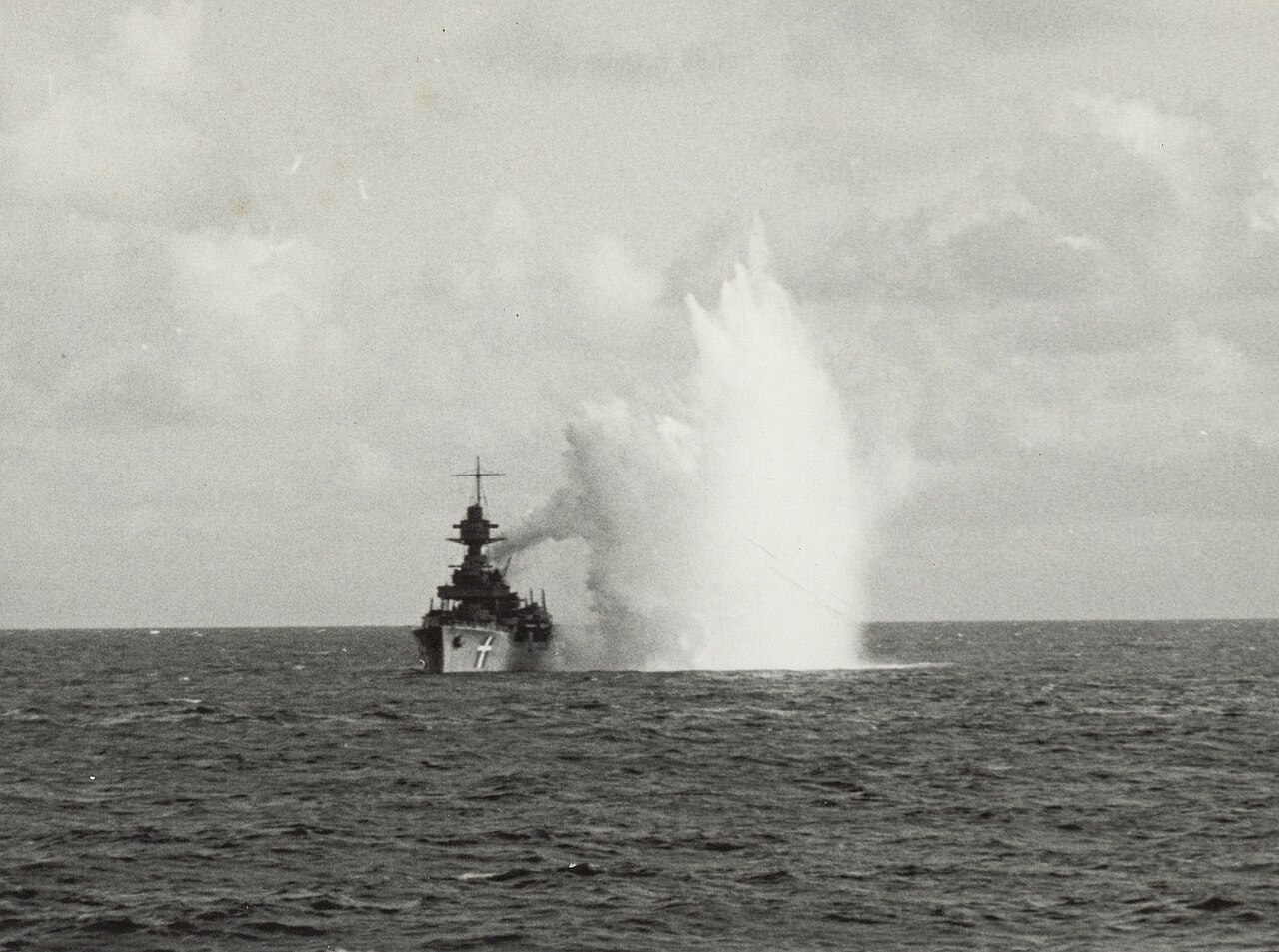 Pacific War Pacific WarCHINA (Fourteenth Air Force): 9 B-25's, with fighter escort, bomb the airfield at Chingmen, China. SOUTHWEST PACIFIC THEATER OF OPERATIONS (Fifth Air Force): In New Guinea, 35 B-24's, escorted by 44 P-38's, strike airfields at Wewak and Boram; and 48 B-25's and 2 B-17's bomb and strafe Alexishafen and Bogadjim areas. A-20's hit dumps at Gasmata. B-24's bomb Babo, New Guinea and Adodo in the Moluccas Islands.
|
|
lordroel
Administrator
Posts: 68,081 
Likes: 49,471
|
Post by lordroel on Aug 30, 2022 5:37:53 GMT
Day 1447 of World War II, August 30th 1943Eastern FrontThe withdrawal in the south began as Taganrog on the Sea of Azoz was abandoned by the Germans. Further to the north, the Soviets rolled forward in the Smolensk area. The Soviet Army scored two more victories as it took Taganrog and Yelnya, a road center on central Russia's Desna river and moved to cut off the Germans in the Crimea. Since the defeat of German panzer divisions at Kursk, the Heer hasn't been able to halt the Soviet tanks that repeatedly have gouged huge holes in its defenses. Air War over Europe297 Lancasters, 185 Halifaxes, 107 Stirlings, 57 Wellingtons and 14 Mosquitoes attacked Monchengladbach and Rheydt, 25 aircraft lost. This was a 'double' attack with a 2 minute pause after the first phase while the Pathfinders transferred the marking from Monchengladbach to the neighboring town of Rheydt. It was the first serious attack on both towns. The visibility was good and the Oboe assisted marking of both targets was described in Bomber Command's records as a 'model' of good Pathfinder marking. The bombing was very concentrated with little creepback. Approximately half of the built up area in each town was destroyed. Only short reports were available from Germany. Monchengladbach recorded 1,059 buildings destroyed - 171 industrial, 19 military and 869 domestic with 117 people killed. The town's telegraph office was the only building mentioned by name. The number of buildings destroyed in Rheydt was given as 1,280 with damage to the main railway station and many rail facilities being stressed and with 253 people being killed. A further 2,152 people were injured and 12 were missing but these last figures were combined ones for the two towns. The 482d Bombardment Group (Pathfinder), a Pathfinder (PFF) group fitted with British Oboe and H2S and US H2X blind-bombing equipment, becomes operational. The US Eighth Air Force's VIII Air Support Command in England flew Mission 38: 33 B-26B Marauders bombed an ammunition dump at Foret d'Eperlecques near Saint-Omer, France without loss. OTU crews made the first of a series of small raids in which they bombed ammunition dumps located in various forests of Northern France. A handful of Pathfinder aircraft marked each target and one of the purposes of the raids was to accustom OTU crews to bombing on to markers before being posted to front line squadrons. This raid was carried out by 33 OTU Wellingtons with the Pathfinders providing 6 Oboe Mosquitoes and 6 Halifaxes. The target was a dump in the Foret d'Eperlecques, just north of St Omer. The bombing was successful and a large explosion was seen. 2 Wellingtons were lost. 12 Mosquitoes went to Duisburg and 9 Stirlings went minelaying in the Frisians. 1 Mosquito was lost. Battle of the AtlanticThe German submarine 'U-634' was sunk in the North Atlantic east of the Azores, by depth charges from the RN sloop HMS 'Stork' and the corvette HMS 'Stonecrop'. All hands on the U-boat, 47-men, were lost. Battle of the MediterraneanThe German General Staff ordered Field Marshal Albert Kesselring's forces to occupy Italy if the Badoglio government surrenders. B-17s of the Northwest African Strategic Air Force bombed Viterbo Airfield and B-25s hit the Civitavecchia marshalling yard. P-40s strafed a radar station at Pula, Sardinia. Also in Italy, Northwest African Tactical Air Force medium and light bombers attacked marshalling yards at Marina di Cantanzaro and Paola, and gun emplacements and bivouac south of Reggio di Calabria and A-36 Apaches bombed marshalling yards at Sapri and Lamezia. In a massive air battle over Italy, 44 US P-38 fighters of the 1st FG, escorting B-26 medium bombers of the 319th and 320th BGs ran into 75 Luftwaffe fighters. The two fighter groups fought as the bombers went on to obliterate the marshalling yards at Aversa. The Americans lost 13 fighters to the German 9. This battle featured substantial inflated claims on both sides. Luftwaffe pilots from JG 53, JG 3 and JG 77 claimed to have shot down at least 32 P-38s and 2 Marauders. The 1st FG claimed 8 Bf 109s including one each from JG 77 and JG 53. The 'Nagwa' was shelled by 'U-596' and sank within three minutes. Photo: HMS Harrow in the Mediterranean. Her stern still has the gallows and a Oropesa minsweeping float is being handled by a small davit, 30 August 1943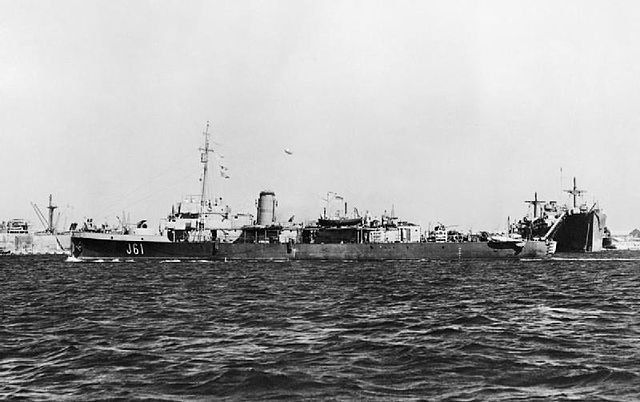 Battle of the Black Sea Battle of the Black Sea'U-18' attacked the Soviet SKA-0132 with the 20mm AA gun and scored several hits before the U-boat had to break off the attack because a floodlight from the coast dazzled the Germans. United StatesPhoto: The U.S. Navy heavy cruiser USS Minneapolis (CA-36) at the Mare Island Naval Shipyard, California (USA), on 30 August 1943, upon completion of overhaul and battle damage repairs - note: SK-1 search radar and gunfire directors mounted atop her foremast and bridge; large false windows painted on her pilothouse, part of a camouflage scheme intended to make her look like a destroyer; sailors pushing a cart full of battle helmets in the lower left; railway boxcars on the pier alongside the ship; lighter YF-280 in the left distance and crane vessel YD-98 at right. Circles mark recent alterations. 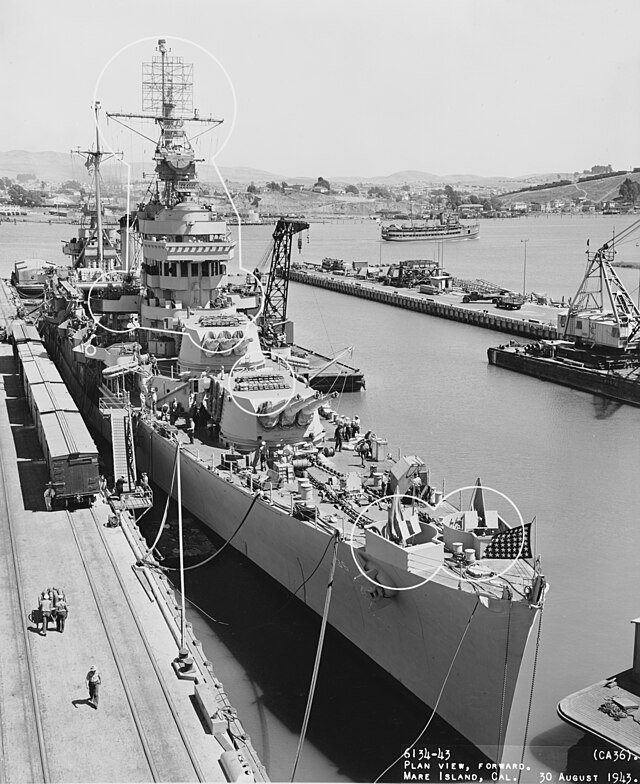 Pacific War Pacific WarCHINA (Fourteenth Air Force): In China, 13 B-25's, some with P-40 support, attack Owchihkow and Shihshow, blasting fuel stores and several buildings; the P-40's strafe gun positions outside Shihshow; 10 P-38's and P-40's on armored reconnaissance from Sinti to Yoyang to Sienning, strafe and bomb several targets of opportunity; 3 locomotives are exploded and another damaged, a water tank is knocked down, and several railroad stations are heavily damaged. 4 other P-40's attack a convoy E of Hong Kong; 1 freighter is hit amidships, causing heavy damage; 2 other vessels are also effectively damaged. In the Solomon Islands, 24 US Thirteenth Air Force B-24s, along with 20 P-40s and P-39 Airacobras and 20+ USMC F4U Corsairs, pound Kahili Airfield on Bougainville Island. Allied airplanes claim more than 30 Japanese shot down; 6 US aircraft are lost. On New Britain Island in the Bismarck Archipelago, US Fifth Air Force B-26s bomb Cape Gloucester Airfield while B-25s sweep along the northwest coast, bombing and strafing barges and enemy-occupied villages. SOUTHWEST PACIFIC THEATER OF OPERATIONS (Fifth Air Force): B-24's pound Dagua, But, and Tadji; and A-20's hit barges on the Bubui River. Lost is P-38H 42-66502. On New Britain Island in the Bismarck Archipelago, B-26's bomb Cape Gloucester Airfield while B-25's sweep along the NW coast, bombing and strafing barges and enemy-occupied villages. The 8th Fighter Squadron, 49th Fighter Group, transfers from Dobodura to Tsili Tsili, New Guinea with P-40's. ALASKA (Eleventh Air Force): The 73d Bombardment Squadron (Medium), 28th Composite Group, based on Amchitka Island with B-25's, begins a movement back to the US. PACIFIC Submarine Halibut (SS-232) sinks Japanese cargo ship Taibun Maru, 41°50'N, 141°13'E.
|
|
lordroel
Administrator
Posts: 68,081 
Likes: 49,471
|
Post by lordroel on Aug 31, 2022 5:33:32 GMT
Day 1448 of World War II, August 31st 1943Eastern FrontThe Red Army advanced south from Sevsk and captured Glukhov and Rylask. Air War over EuropeBattle of Berlin cont.: RAF Bomber Command dispatched 613 aircraft: 331 Lancasters, 176 Halifaxes, 106 Stirlings with nine Oboe Mosquitoes as route markers. 47 aircraft lost, among them was Lancaster JB132 which collided with Lancaster R5698 of 1654 HCU after the raid and crashed at Beasley Moreton, Nottinghamshire. The crew were S/Ldr D.C. Wellburn, F/Lt R.E. Davies, F/O R.L. Clarke, F/O T.F. Joyce, Sgt J. Blackett, Sgt J.R. Forrest, Sgt A. Paterson and Sgt J.K. Watson, from 61 Sqdn. The Stirling casualties were 16%. This raid was not successful. Many of the crews were tired, having had only a few hours sleep since the raid of the previous night. The force was easily tracked on its approach and at least 18 bombers were shot down by fighters. Twenty-two aircraft, mostly Stirlings and Halifaxes were shot down in the target area and during the initial 70 miles of the journey back to England. Approximately two thirds of the bombers lost were shot down by German fighters operating over or near Berlin. The use of 'fighter flares' dropped by German aircraft to 'mark' the bomber routes into and away from the target was noted for the first time in Bomber Command records. There was some cloud in the target area. This, together with difficulties with H2S equipment and probably the ferocity of the German defences, all combined to cause the Pathfinder markers to be dropped well south of the centre of the target area and the Main Force bombing to be even further away.The main bombing area eventually extended 30 miles back along the bombers' approach route. 85 dwelling houses were destroyed in Berlin but the only industrial buildings hit were classed as damaged, 4 severely and 3 lightly. The only important public buildings hit were the headquarters of the Berlin inland canal and harbour system, the state police hospital and some market halls. 66 civilians and 2 soldiers were killed, 109 people were injured nd 2,784 bombed out. After this raid Gauleiter Goebbels ordered the evacuation from Berlin of all children and all adults not engaged in war work to country areas or to towns in Eastern Germany where air raids were not expected. A total of 377 bombing photographs were examined. Only ten of the photos showed aircraft bombing in the center of Berlin. Most bombs fell in a long spread 30 miles south of Berlin, scattered in a wide area of the south. Sixty-eight people were killed in Berlin and 19 in the countryside. US Ninth Air Force B-24s bombed the marshalling yard at Pescara and claimed 9 enemy fighters destroyed. About 150 Northwest African Strategic Air Force B-17s blasted the Pisa marshalling yard, doing a large amount of damage. Northwest African Tactical Air Force medium and light bombers bombed the Cosenza marshalling yard and road-railway junction in Cantanzaro during the morning, and in the afternoon bombed the area around Cosenza when clouds prevented hitting specific targets; and fighter-bombers hit Sapri railroad and seaplane base; and during the night light bombers hit the bivouac areas southeast of Reggio di Calabria. During this month RAF Bomber Command losses, killed or POW, were 2,030. The US Eighth Air Force's VIII Air Support Command and VIII Bomber Command both fly missions against targets in France. The US VIII Air Support Command flew Missions 41 and 42: 104 B-26B Marauders bombed the Rouen and Mazingarbe power stations, Poix/Nord and Lille/Nord Airfields and the Hesdin fuel dump. 1 B-26 was lost. The US VIII Bomber Command flew Mission 88 against two aviation locations. 105 B-17 Flying Fortresses attacked Glisy Airfield at Amiens and claimed 5-1-3 Luftwaffe aircraft. 3 B-17s were lost. 149 B-17s were dispatched to the aircraft plant at Meulan. The plant was cloud covered and 1 B-17 hit a railway northeast of Rouen. These missions were escorted by 160 P-47 Thunderbolts which claimed 2-1-1 Luftwaffe aircraft. 2 P-47s were lost. 30 Wellingtons with 6 Mosquitoes and 5 Halifaxes of the Pathfinders bombed an ammunition dump in the Foret de Hesdin and 6 Mosquitoes were sent to Brauweiler without loss. Battle of the MediterraneanNegotiations for Italy's surrender resumed near Syracuse, with General Giuseppe Castellano of the Italian General Staff pleading with the Allies to occupy Rome and protect King Victor Emmanuel and the Badoglio government. U. S. General Walter Bedell Smith insisted on unconditional surrender, with the armistice to be announced as a large Allied army lands in Italy. Smith refused to tell Castellano where the Allies would come ashore or how large the army would be. Disappointed by the unconditional surrender demand and fearful of the large numbers flooding into Italy, Castellano returned to Rome to confer with Italy's new head of state, Marshal Pietro Badoglio. Battle of the Baltic SeaSoviet motor torpedo boat TK 94 sank the Finnish minelayer 'Riilahti'. 24 men, including the commander, Knight of the Mannerheim Cross, Lt.-Cdr Osmo Kivilinna were lost. German occupied FranceThe Japanese submarine I-8 reached Brest from Singapore. North AfricaPhoto: DUKWs carrying 6-pdr anti-tank guns during training in North Africa, 31 August 1943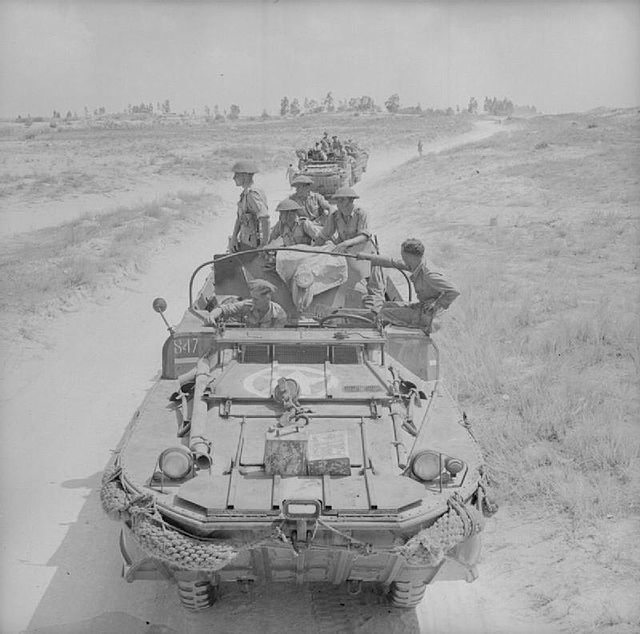 Photo: A 6-pdr anti-tank gun is loaded onto a DUKW during training in North Africa, 31 August 1943 Photo: A 6-pdr anti-tank gun is loaded onto a DUKW during training in North Africa, 31 August 1943 Pacific War Pacific WarCHINA (Fourteenth Air Force): In French Indochina, 7 B-24's bomb Gia Lam Airfield; and 22 P-40's and 2 P-38's bomb a dike near Co Bi barracks. 6 B-25's hit Ichang Airfield, China while 3 others attack an oil storage area to the E; P-40's also hit the oil stores. 3 P-40's claim heavy damage to a freighter off Stonecutter's Island near Hong Kong. In China, 4 P-38's dive-bomb Yoyang railroad yards and Sinti warehouses; a P-38 is shot down by ground fire. JAPANESE OCCUPIED FRENCH INDOCHINA: Seven USAAF Fourteenth Air Force B-24 Liberators bomb Gia Lam Airfield and 22 P-40s and two P-38 Lightnings bomb a dike near Co Bi barracks. JAPANESE OCCUPIED EAST INDIES In the air in the Netherlands East Indies, (1) USN PBY Catalinas sink small Japanese cargo vessels off Ceram; (2) RAAF Mitchells sink a small Japanese cargo vessel off north coast of Alor Island; and (3) U.S. aircraft sink a guardboat off Halmahera Island. NORTH PACIFIC The USN's Task Force 15, consisting of the aircraft carriers USS Essex with Carrier Air Group Nine (CVG-9), USS Independence with Light Carrier Air Group Twenty Two, and USS Yorktown with CVG-5 with a battleship, 2 light cruisers and 11 destroyers, attack Marcus Island located about 725 miles NW of Wake Island. A total of 275 sorties are flown against the Japanese and several IJN "Bettys" are destroyed and ground facilities are heavily damaged. This strike marks the combat debut of the Grumman F6F Hellcat. The fighting squadrons on all three aircraft carriers are equipped with F6F-3s, (VF-5) in USS Yorktown, VF-9 in USS Essex and detachments of VF-6 and VF-22 in USS Independence. The Hellcats destroy four aircraft on the ground and later in the day, an F6F pilot shoots down a Japanese aircraft. Photo: Marcus Island (Minami Torishima) under attack by U.S. Navy aircraft of Carrier Air Group 5 (CVG-5) from the aircraft carrier USS Yorktown (CV-10), on 31 August 1943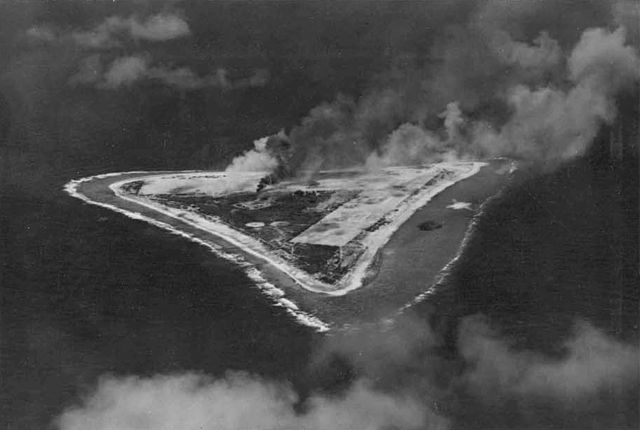 Photo: Marcus Island (Minami Torishima) under attack by U.S. Navy aircraft of Carrier Air Group 5 (CVG-5) from the aircraft carrier USS Yorktown (CV-10), on 31 August 1943 Photo: Marcus Island (Minami Torishima) under attack by U.S. Navy aircraft of Carrier Air Group 5 (CVG-5) from the aircraft carrier USS Yorktown (CV-10), on 31 August 1943 Photo: Aerial view attack on Minamitori Island (formerly Marcus island) on 31 August 1943. The photo was taken from a plane from the USS Yorktown Photo: Aerial view attack on Minamitori Island (formerly Marcus island) on 31 August 1943. The photo was taken from a plane from the USS Yorktown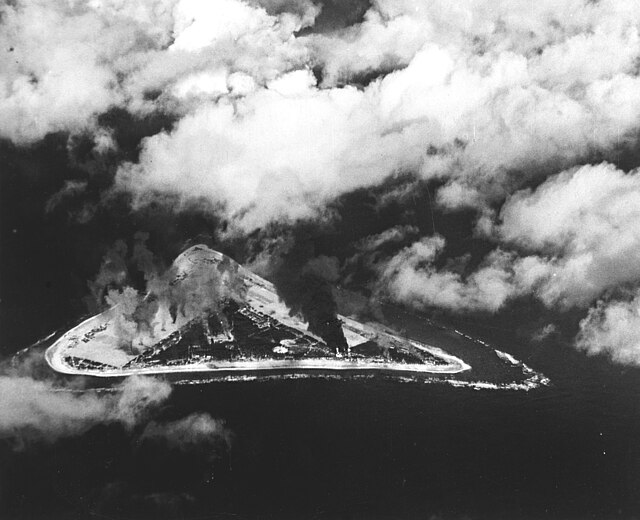 SOUTH PACIFIC THEATER OF OPERATIONS (Thirteenth Air Force): P-40's, in a running battle over Vella Lavella, claim 5 Japanese airplanes shot down; other P-40's strafe barges in Timbala Bay on Vella Lavella Island. 22 B-25's and 50 US Navy airplanes bomb gun positions and the radio station at Vila. BISMARCK ARCHIPELAGO (Fifth Air Force): Bombers fly scattered strikes against shipping and shore targets in the Saint George Channel and in the Netherlands East Indies. Lost is B-24D "Little Beaver" 42-40984. PACIFIC Tank landing craft LCT-154 is lost during amphibious operations, 37°8'N, 10°58'E. Submarine Seawolf (SS-197) damages Japanese torpedo boat Sagi and sinks army cargo ship Shoto Maru and merchant cargo ship Kokko Maru, 28°30'N, 123°05'E. U.S. tanker W.S. Rheem is torpedoed by Japanese submarine I-20 near Espiritu Santo, 15°51'S, 167°02'E, but reaches port under her own power; there are no casualties to either the 49-man merchant complement or the 25-man Armed Guard.
|
|
lordroel
Administrator
Posts: 68,081 
Likes: 49,471
|
Post by lordroel on Sept 1, 2022 6:11:08 GMT
Day 1449 of World War II, September 1st 1943
Eastern Front
Soviet troops made good progress around Smolensk and Vyazma capturing Dorogobuzh, east of Smolensk, and south around Taganrog.
Air War over Europe
30 RAF OTU Wellingtons with 6 Mosquitos and 5 Lancasters of the Pathfinders successfully bombed an ammunition dump in the Forêt de Mormal, 8 Mosquitos were sent to Cologne and Duisburg, 89 aircraft were minelaying in the Frisians, near Texel and off Brittany and Biscay ports. 1 Stirling minelayer was lost.
7 aircraft of RAF No. 305 Sqdrn (Polish) took off for a night attack on enemy rail movements in France Belgium and all aircraft successfully carried out their tasks. RAF No. 317 Sqdrn (Polish) flew to Manston in the morning. Fourteen aircraft took off at 0850 hours led by S/LDR. KORNICKI, F. Several operations seemed probable but none did infact materialize, and the aircraft returned again to Fairlop at about 1600 hours. The weather was apparently too cloudy for bombers to operate. Two aircraft of “A” Flight carried out tests. Six aircraft escorted Mustangs to Bologne.
Battle of the Atlantic
The USN assumed full responsibility for all airborne antisubmarine operations by US forces in the Atlantic and USAAF units were reassigned. The 5th and 13th Anti-submarine Squadrons (Heavy), 25th Antisubmarine Wing, ceased flying ASW patrols from Westover Field, Massachusetts and Grenier Field, New Hampshire respectively with B-24s. The 5th was redesignated the 827th Bombardment Squadron (Heavy) on 1 Oct 43 and would arrive in Italy in Apr 44 with B-24s. The 13th was redesignated 863d Bombardment Squadron (Heavy) and would arrive in England in Jan 44 with B-17s.
Battle of the Mediterranean
NAAF P-40s bombed a zinc plant at Iglesias and strafed a factory north of Gonnesa while medium and light bombers hit Bova Marina, areas near Salina and Sant' Eufemia d'Aspromonte town area and a bridge at Oliveto.
All Administrative functions of the Army Air Forces elements of the Northwest African Air Force were transferred to the appropriate US Twelfth Air Force organizations. Operational control remained with the Northwest African Air Force. The 506th Bombardment Squadron (Heavy), 44th Bombardment Group (Heavy), ceased operating from Benina, Libya with B-24s and returned to it's base at Shipdham, England
Pacific War
ALEUTIAN ISLANDS CAMPAIGN
2 P-40's attempting to intercept Japanese aircraft reported near Attu abort because of weather.
CORAL SEA
In the Coral Sea, USN destroyer USS Wadsworth picks up an underwater sound contact and drops seven patterns of depth charges sinking Japanese submarine HIJMS I-20 about 148 nautical miles NNE of Port Vila, Espiritu Santo Island, New Hebrides Islands, in position 15.38S, 166.57E.
BAKER ISLAND
The US Army's 804th Engineer Aviation Battalion lands on Baker Island, about half way between Australia and the Territory of Hawaii, to build an advance airfield to support the upcoming invasions in the Gilbert Islands. The landing is supported by the USN's Task Force 11 (Rear Admiral Willis A. Lee, Jr.), formed around small aircraft carriers USS Princeton and Belleau Wood. The dock landing ship USS Ashland (LSD 1) in this operation pioneers the use of this type of ship in amphibious operations. Also involved are the PBY-5A Catalinas of USN VP-33 based on Canton Island. The squadron conducted day searches toward the Gilberts covering the occupation of Baker Island.
From this date through 14 Sep, 8 B-24's conduct daily sea-search operations from Canton in the Phoenix Islands.
INDIA
(Tenth Air Force): A detachment of the 9th Photographic Squadron, Tenth Air Force, based at Pandaveswar, India begins operating from Dinjan, India with F-4's and F-5's. The 459th Fighter Squadron is activated at Karachi, India and assigned to the 80th Fighter Group. The squadron begins training with P-38's.
BURMA
USAAF Tenth Air Force B-24 Liberators bomb rail facilities at Mandalay.
CHINA
7 B-25's, supported by 8 P-40's, attack a Japanese destroyer at Shihhweiyao; no hits are scored on the ship but considerable damage is done to the surrounding dock area; 6 P-40's sink a small tanker down river from Ichang, damage 2 large boats between Ocheng and Shihhweiyao, and strafe cavalry troops at Ocheng; 3 other P-40's heavily damage a small ship at Swatow harbor and strafe the nearby airfield; 3 P-38's and a P-40 dive-bomb and strafe barracks at Yangsin, demolishing 3 buildings; and 2 nearby locomotives are also destroyed. The fighter-bombers then heavily damage a small steamer at Wuchang, sink 1 tug and damage another at Kutang, and blast a train and an AA position S of Puchi. During Sep 43, HQ 23d Fighter Group transfers from Kunming to Kweilin, China. During Sep 43, detachments of the 449th Fighter Squadron, 51st Fighter Group based at Lingling, China operate from Hengyang and Kweilin, China with P-38's.
SOUTHWEST PACIFIC
(Fifth Air Force): 70+ B-24's and B-25's hit the Alexishafen / Madang area, dropping 201 tons of bombs (heaviest by Fifth Air Force to date). Other B-25's hit Iboki Plantation in the Bismarck Archipelago, barges on the Bubui River in New Guinea, the Rein Bay on New Britain area and several villages in New Britain. B-17's bomb Labu , New Guinea. B-26's attack Cape Gloucester area on New Britain . B-24's and B-25's strike targets in the Lesser Sunda . The 68th and 69th Troop Carrier Squadrons, 433d Troop Carrier Group, arrive at Port Moresby from the US with C-47's. The 432d Fighter Squadron, 475th Fighter Group, ceases operating from Port Moresby and returns to it's base at Dobodura with P-38's.
SOLOMON ISLANDS: On Vella Lavella Island, a battalion of the U.S. 35th Infantry Regiment, 25th Infantry Division, driving on the Kokolope Bay, reaches the Orete Cove area, about 14 miles (23 kilometers) northeast of Barakoma.
PACIFI
Naval Air Station, Kahului, Maui, T.H., is established.
Destroyer Wadsworth (DD-516) sinks Japanese submarine I-182 off Espiritu Santo, New Hebrides, 15°38'N, 166°57'E.
Submarine Pompano (SS-181) sinks Japanese merchant vessel Nankai Maru off Miyako.
|
|
lordroel
Administrator
Posts: 68,081 
Likes: 49,471
|
Post by lordroel on Sept 2, 2022 4:00:47 GMT
Day 1450 of World War II, September 2nd 1943Eastern FrontRed army forces liberated Lisichansk and Kommunarsk in the Donets while to the north, Sumy and Glushkovo were recaptured. Air War over Europe The US Eighth Air Force in England dispatched both the VIII Air Support Command and the VIII Bomber Command to attack targets in France. The VIII Air Support Command flew Missions 41 and 42: 216 B-26B Marauders were dispatched to 5 targets in France (36 per target). The missions to a power station at Rouen and Poix/Nord and Lille/Nord Airfields were aborted due to weather but 35 B-26s hit a power station at Mazingarbe and 69 hit a fuel dump at Hesden. 1 B-26 was lost. The VIII Bomber Command flew Mission 89 against airfields in France but because of unfavorable cloud conditions only part of one force was able to attack a target. B-17 Flying Fortresses were dispatched to airfields in northwestern France but the mission was abandoned at the French coast due to heavy clouds. 34 of 86 B-17s dispatched to Mardyck and Denain/Prouvy Airfields hit the target at 1922 and 1905 hours respectively. 182 P-47 Thunderbolts were dispatched to escort the bombers but they carried out fighter sweeps. 3 P-47's were lost. 30 Wellingtons, 6 Mosquitoes and 5 Lancasters successfully bombed an ammunition dump in the Foret de Mormal. 8 Mosquitoes were sent to Cologne and Duisburg. 89 aircraft were minelaying in the Frisian Islands, near Texel and off Brittany and Biscay ports. 1 Stirling minelayer lost. Battle of the MediterraneanAlmost 200 B-17s and B-25s of the US Twelfth Air Force bombed marshalling yards at Bologna, Trento, Bolzano, and Cancello Arnone; bombers and fighters escorting the B-25s claimed 28 enemy airplanes shot down; and tactical aircraft, including RAF and US Ninth Air Force airplanes, hit gun positions and other targets on the Italian toe, bombed rail communications at Bova Marina, Locri, Marina di Monasterace, Siderno Marina, Lamezia, and Catanzaro, and attacked barges in the Golfo di Sant' Eufemia and an ammunition dump at Saptri. Shortly after noon, fighters from II./JG 53 intercepted the Allied flight of bombers attacking the marshalling yards at Cancello Arnone but were bounced by the escorting flight of P-38s. 10 P-38s were shot down but at a cost. as Oblt. Franz Scheiss (67 kills) was shot down. Other German air units involved were JG 3, JG 53 and JG 77 and claimed at least 18 P-38s destroyed. The Italian mainland defenses near Reggio were shelled by British battleships HMS 'Valiant' and HMS 'Warspite'. Photo: Troops from 5th Division go aboard landing craft at Catania, Sicily, in preparation for the invasion of the Italian mainland, 2-3 September 1943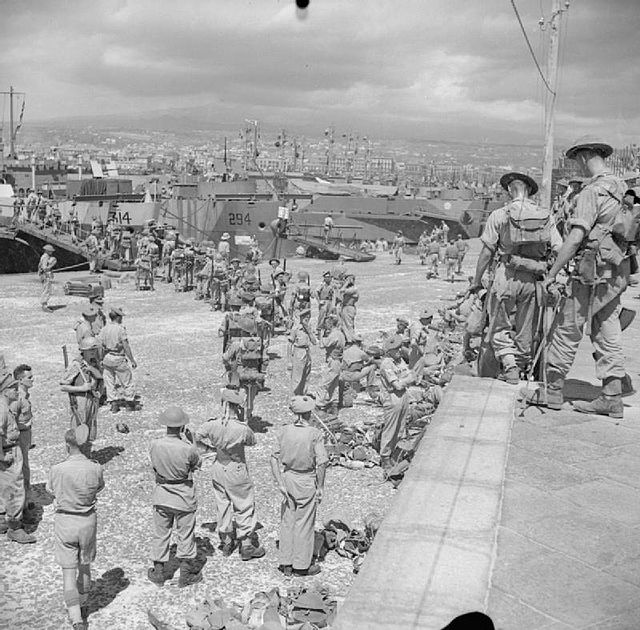 Photo: Troops from 2nd Battalion, The Northamptonshire Regiment wait to board landing craft at Catania, Sicily, for the invasion of Italy, 2 September 1943 Photo: Troops from 2nd Battalion, The Northamptonshire Regiment wait to board landing craft at Catania, Sicily, for the invasion of Italy, 2 September 1943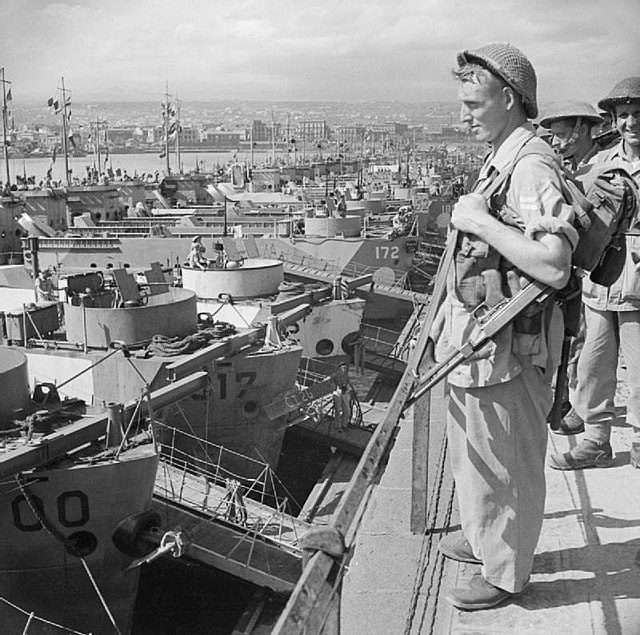 Photo: Troops from 51st Highland Division boarding landing craft at Catania, 2 September 1943 Photo: Troops from 51st Highland Division boarding landing craft at Catania, 2 September 1943 Germany Germany Hitler appointed Albert Speer, the minister of armaments and munitions, to the new post of Reich minister for arms and war production. Middle East Photo: 6th South African armored division in training in the Middle East, 2 September 1943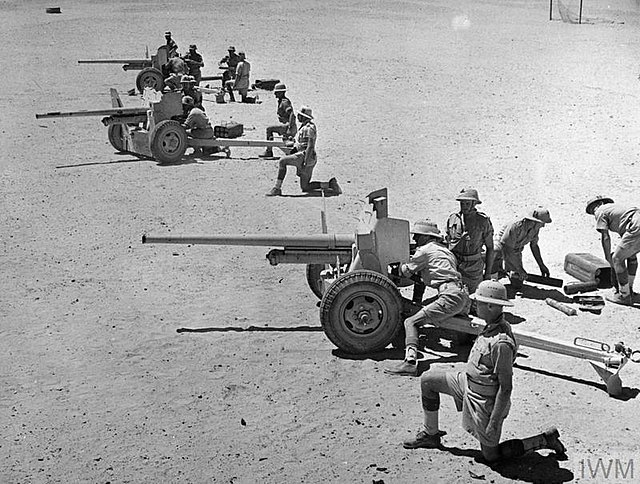 Pacific War Pacific WarCHINA-BURMA-INDIA (Fourteenth Air Force): 10 B-25's and 5 P-40's bomb Hong Kong hit- ting the Kowloon area and attack shipping off Stonecutter's and in the Lai Chi Kok area. CHINA Lieutenant General Joseph Stilwell, commander of the U.S. China-Burma-India Theater, Chief of Staff to Chinese Generalissimo Chiang Kai-Shek, commander of the Northern Area Combat Command and deputy commander of the South-East Asia Command, issues “A Program for China,” in which he recommends that 60 Chinese Nationalist divisions be reformed. NEW GUINEA CAMPAIGN In Northeast New Guinea, Australian troops encounter strong resistance around the town of Finschhafen while the 2/2nd Independent Company ambushes the Japanese near Kesawai in the Ramu River Valley inflicting heavy casualties. SOUTH PACIFIC (Thirteenth Air Force): 24 B-25's and 60+ US Navy aircraft pound Vila, hitting AA and artillery positions and the area E of Ringa Cove on New Georgia. 18 B-24's, 20+ P-40's and P-39's, and 60+ USN planes attack Kahili; shore installations, the airfield, and bridges N of the strip are hit. SOUTHWEST PACIFIC (Fifth Air Force): B-25's, with P-38 escort, attack shipping at Wewak Harbor, claiming 1 vessel sunk and 2 left aflame; 10 enemy interceptors are claimed destroyed; barrage balloons offer some protection to the enemy ships. This is first AAF observation of Japanese use of such balloons in the Southwest Pacific Area. Lost are B-25D 41-30319, B-25D 41-30225, B-25D 41-30247, B-25D 41-30255. PACIFIC Destroyer Kendrick (DD-612) is damaged by aerial torpedo, 36°42'N, 00°47'E. Submarine Bowfin (SS-287) delivers supplies and evacuates certain people from Binuni Point, Mindanao. Submarine Seawolf (SS-197) sinks Japanese army cargo ship Fusei Maru, 31°28'N, 127°24'E. Submarine Snapper (SS-185) sinks Japanese escort vessel Mutsure, 85 miles north-northwest of Truk, Carolines, 08°40'N, 151°31'E. USAAF B-25s and P-38s pound Japanese convoy off Wewak, sinking army cargo ships Nagato Maru and Hankow Maru, and damaging Nagano Maru.
|
|


































